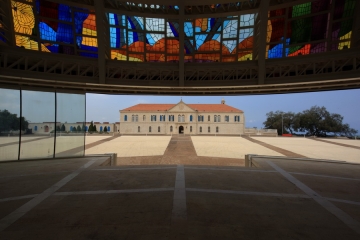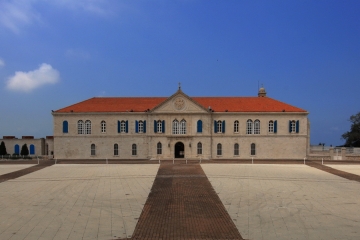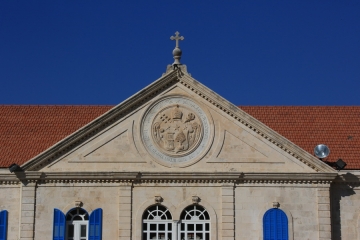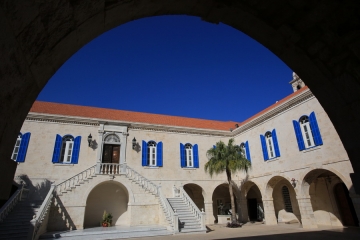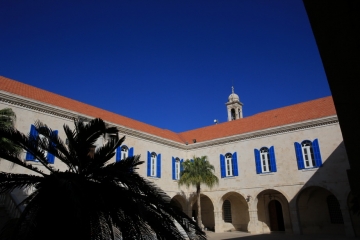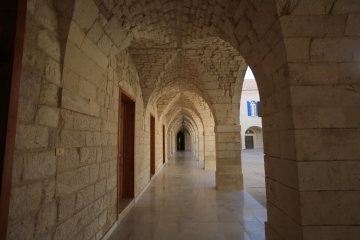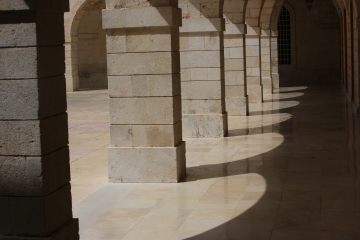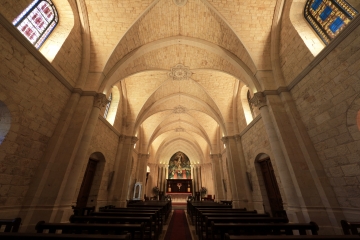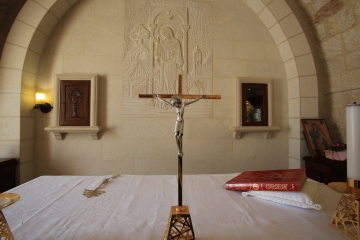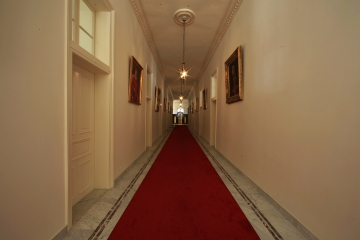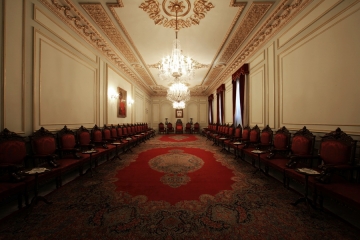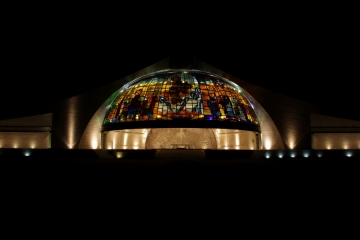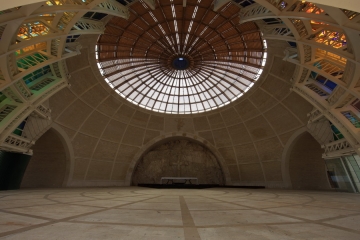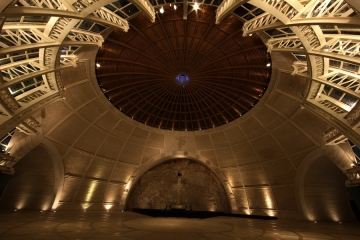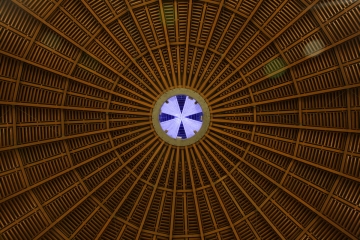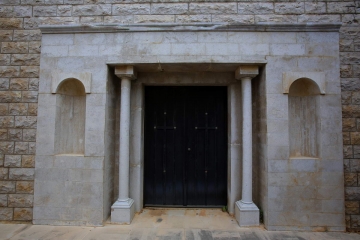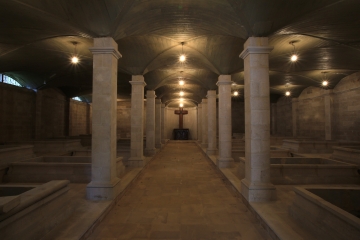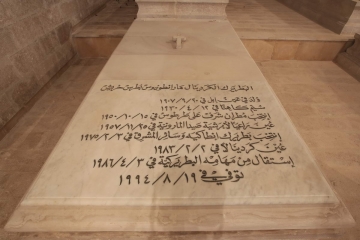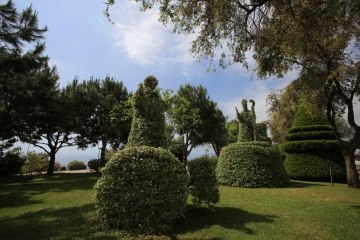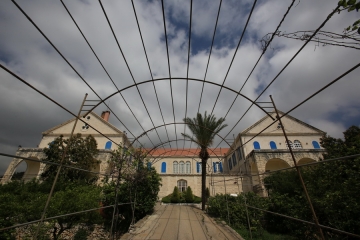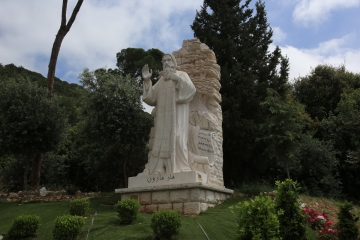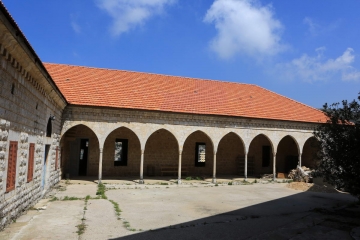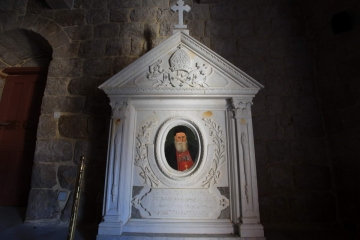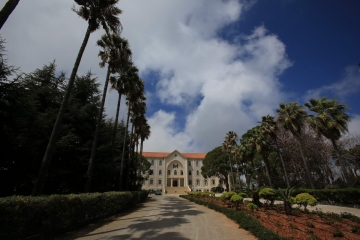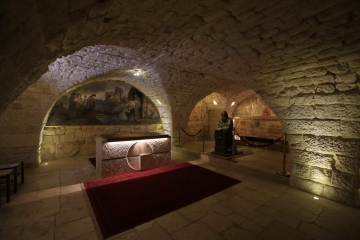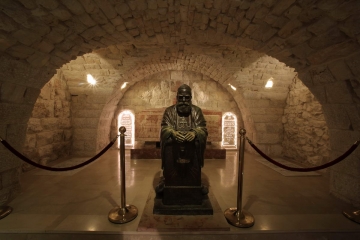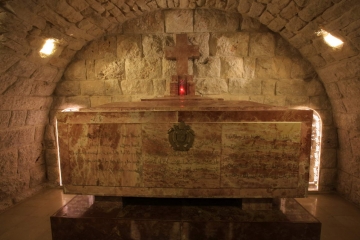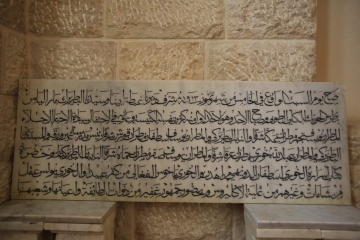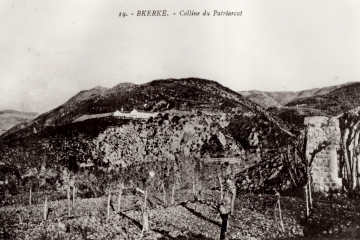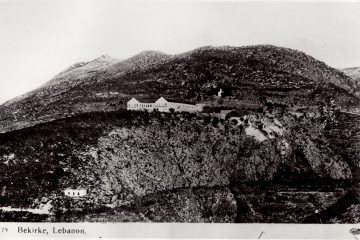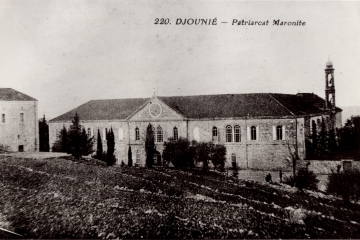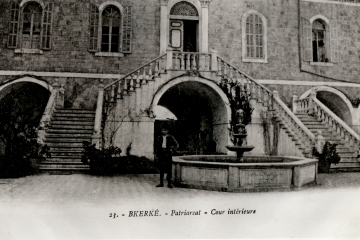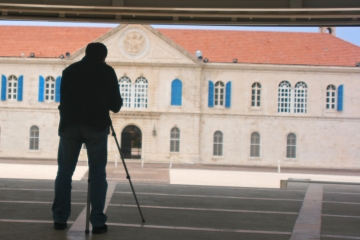دير سيّدة بكركي
في الثالث من كانون الأول 1790 إلتأم في دير سيّدة بكركي المَجمَع الماروني برئاسة البطريرك يوسف اسطفان (1766-1793)، وفي الجَلسَة التاسِعة من جَلساته التي انعقدت في الثاني عشر من هذا الشهر أَقرَّ آباء المجمع بالإجماع ما يلي:
"إننا بعد النظر في كل الظروف، واعتبارنا ضَرورة إيجاد مكان في كسروان يكون كُرسيّا ثابتاً لبطاركتنا، قد رأينا أن الطريقة الأكمل والأكثر فائدة لخير الطائفة هي أن يكون دير بكركي مَقراً ثابتاً لهذا الكُرسيّ، وأن تَكون كل خيراته الثابتة وغير الثابتة مُلكاً مؤبداً لكُرسيّنا البطريركي".
ولكنَّ هذا الدير لم يُثبَّت فعلياّ كمَقرٍّ دائمٍ للبطاركة الموارنة إلاّ بعد مُحاولات عديدة ومِراجعات مُتكرِرَة أجراها البطاركة مع الكُرسيّ الرسولي. والصعوبة التي كانت تَقِف حاجزاً بوجه محاولاتهم هذه كانت مُخالفتها لقرار المَجمَع اللبناني المُنعقد سنة 1736 والذي قضى بأن يكون مَقرّ البطاركة الموارنة الدائم دير سيّدة قَنّوبين.
فلِئلاّ يَبقى قرار المَجمَع اللبناني هذا حِبراً على ورق، حاول البطاركة وراجعوا أكثر من مرةٍ الكُرسيّ الرسولي في شأن نقل مَقرهم المقرّر في دير سيّدة قَنّوبين إلى مكانٍ آخر أكثر أماناً وسلاماً، فكان جَواب مَجمَع نشر الإيمان إن البطريرك وأساقفة الطائفة في مَجمَع طائفيٍ عامّ يُمكِنهم أن يُقرّروا نقل مَقر إقامة البطريرك إلى مكان آخر أكثر مُلاءمةً، وجواب المَجمَع هذا جُدد أكثر من مرة قبل أن يُصبح قراراً نافذاً مُصدّقاً عليه من الكُرسيّ الرسولي في 13 آذار 1796.
وقد سَبق صُدور هذا القرار انعقاد ثلاثة مَجامِع عامة، قرَّرَ فيها الآباء الحاضِرون نَقل مَقر الكُرسيّ البطريركي من دير سيّدة قَنّوبين إلى دير سيّدة بكركي، فكان القرار واحداً في المَجامِع الثلاثة.
فالمَجمَع الأول الذي قَرَّر آباؤه جَعل دير سيّدة بكركي مَقراً للبطاركة الموارنة كان مَجمَع ميفوق الذي إنعقد في 21 تموز سنة 1780، والذي في جلسته الثالثة المنعقدة في 24 تموز من السنة المذكورة، تمَّ رأي آباء المَجمَع في شأن إقامة السيّد البطريرك على ما يلي: "قد اتفق رأي مَجمَعنا بأن دير بكركه يكون كُرسيّاً لبَطركنا حين إقامته في كسروان".
وأمّا المَجمَع الثاني الذي قرّر جَعل دير بكركي مَقراً ثابتاً للبطاركة الموارنة، فكان مَجمَع عين شقَيْق الذي عُقد بأمر البابا بيوس السادس (1775-1799) يوم 6 ايلول سنة 1786، والذي، في جلسته السادسة التي عُقدت في 9 ايلول، أصدر القرار التالي:" لمّا كان المَجمَع المُقدَّس قد أمر بإحالة دير بكركي إلى ما به خير الطائفة فقد قَضَى المَجمَع (أي مَجمَع عين شقَيْق) بأن يكون الدير المذكور مع أملاكه وقفاً مؤبداً للكُرسيّ البطريركي ومَقراً للبطريرك والمطارنة".
والمَجمَع الثالث والأخير كان مَجمَع بكركي الذي ذكرناه آنفاً. ولكن رغم القرار الموحّد الذي صدر عن هذه المجامع الثلاثة فإن هذا القرار لم يُنفّذ بالسرعة المرجوّة، بل ظَلّ البطاركة يواجهون صعوباتٍ كثيرةٍ أمام تنفيذه طوال ما فوق الربع قرن.
وفي أيام البطريرك يوسف التِيّان حاول الأساقفة برئاسته أن ينقِضوا هذا القرار، وينقلوا مَقرّ سكن البطريرك رسمياً إلى دير مار شليّطا مقبس.. بعد أن سكنه البطريرك التيان منذ انتخابه، إذ اجتمعوا في دير سيّدة قَنّوبين بتاريخ 4 ايار 1808، كما أشرنا إلى ذلك في حديثنا عن دير مار شلّيطا مقبس، وقرّروا في جمعيتهم العامة هذه نقل مَقر البطريرك من دير بكركي إلى دير مار شليطا مقبس قرب غوسطا، وبيّنوا في عريضة موقّعة منهم جميعاً ومَختومة بأختامِهم الأسباب الصوابية الداعية إلى نقل هذا المَقر. ولكنّ قرارهم هذا لم ينفّذ رسمياً بِسِبب استقالة البطريرك التيان، عِلماً بأن بعض البطاركة كان قد اتخذه بالفعل مَقراً له، وكنا قد أشرنا إلى ذلك في الفصل الذي خَصّصناه لدير مار شليطا مقبس.
وبعد استعراضنا المراحل التي أفضت إلى اعتماد دير سيّدة بكركي مَقراً نهائياً للبطاركة الموارنة نأتي في ما يلي على لَمحَة تاريخية عن هذا المَقر.
كلمة "بكركي" هي في الأصل اسم لموقع طبيعيّ يقوم على تلة صغيرة تُشرف على مدينة جونيه من جِهتها الجنوبية الشرقية، وعندما أقيم عليه دير رهبانيّ اتخذ هذا الدير اسم الموقع فدُعي "دير سيّدة بكركي"، ولمّا أصبح في ما بعد كُرسيّاً بطريركياً للطائفة المارونية أصبحت كلمة "بكركي" تعني ذلك، أي مركز الرئاسة الروحية للطائفة.
وقد أُعطيت تَفسيرات عِدّة مُتناقضة لمَعنى هذه الكلمة. فمن الباحثين والمؤرخين مَن قال انها مُشتقة من اسم طائر "الكركي" الذي كان يُشاهَد قديماً في هذا الموقع، ومِنهم مَن ردّ أصلها إلى اللغة السريانية معتبراً إياها مركَّبة من لفظتين: "بيت" و"كركي" بفَتح الكاف الأولى، فَجرى إدغامِهما في كلمة واحدة هي "بيت-كركي" ومَعناها المكان المُسوّر والمُحصّن أو المكان المُستدير. والبعض لم يُخالف بكونها آتية من "بيت-كركي" وإنما، بتَحريكه الكاف الأولى والثانية فيها بالكسر، أعطى لها معنىً آخر هو المكان الذي تُحفظ فيه الأدراج والأسفار والطوامير، أي بتعبيرنا الحاضر "المكتبة"، وهذا في رأي هؤلاء مُطابِق للواقع لأن المَقرّ البطريركي يحَتوي في مكتبته على أدراج ووثائق وطوامير. ولكنَّ هذا التفسير يَسقُط أمام كون المَكان قد عُرف بهذا الاسم قبل َن يشيّد فيه دير يضمّ مَكتبة كالتي ذكرنا. ففي "تاريخ الأزمنة" للبطريرك اسطفان الدويهي حديث عن "رجل كسرواني من ضَيعة تُسمّا (تُسمّى) بكركه فوق جونيه". والأب بولس صفير، حافِظ المكتبة البطريركية سابقاً، في كتابه "بكركي في مَحطاتها التاريخية"، يَستبعِد ان يكون اسم "بكركي" يعني المكان الذي تُحفظ فيه الأدراج والطوامير.. ويميل إلى الاعتقاد بأن معناه هو "المكان المُستدير" او "المكان المُحصّن" الذي ينطبق على الموقع الجغرافي للدير.
ويُستفاد من وثائق تاريخيّة قديمة كانت في حوزة البطريرك بولس مسعد (1854-1890) إن مَوقع دير بكركي لم يكن في البداية حيث يقوم الصرح البطريركيّ الحاليّ، بل كان مَبنياً قرب كنيسة سيّدة البشوشة الكائنة في الحِرج المجاور لموقع الصرح الحاليّ.
وتاريخ تَشييده يعود إلى العام 1703 وذلك من قِبَل الشيخ خطار الخازن، وقد تَسِلّمُه منه بعدئذِ الرهبان الأنطونيون سنة 1730. وكان عِبارة عن كنيسة صغيرة وبِقربها بيت للِكاهن. وتفاصيل تَشييد هذا الدير القديم، وطريقة تسليمه للرهبان الأنطونيين، نأخذها عن لِسان القاصِد الرسولي في جبل لبنان دازيداريو في تقرير رَفَعه إلى مَجمَع انتشار الإيمان في 23 ايلول سنة 1753، وعَرّبه القَس بولس عَبّود في كتابه "المجالي التاريخية"، وفَحواه أن الشيخ خطار الخازن كان يَملك قِسماً من تلة بكركي وبعض أراضٍ يجري غرسها، فبنى في هذه الأرض كنيسة دُعيت "سيّدة بكركي". وأراد أن يَجعل لها كاهناً يقيم القداس لأهل الجوار، فاشترى بعض الأملاك والأراضي الحرجية من عائلة بيت الشمالي في درعون وبنى عليها بعض الغرف لِسكن كاهن الرعية.
وجاءه يوماً شَخص يُدعى نَصر العيادي (يقول الأب بولس صفير في كتابه "بكركي في محطاتها التاريخية" ان الاسم الصحيح لنَصر هذا هو نَصّار بن مفرّج الحادي من زوق مصبح) عارضاً عليه أن يوقف على هذه الكنيسة كل ماله، مُقابل أن يَسكُن هناك ليحيا حياة عِزلة، فقبل منه الشيخ ذلك وسَمَح له بأن يقيم في دير سيّدة بكركي. فأخذ هذا في إكمال البناء على نفقته، وكان مؤلفاً من أربع او خمس غرف صغيرة وليس له شكل دير، كما اشترى بعض قُطع الأرض ليجعل منها مع الكنيسة أنطشاً للرهبان الكرمليين. فاشترط عليه الشيخ ان يقيم معه كاهن واحد على الأقل، ثم صَرَف الرهبان الكَرمَليين وجَعل مَكانهم راهباً أنطونياً من ريفون، فلم يَستطع أن يُقيم مع نصر لكون هذا الأخير فظاً غليظاً، فَصَرفه الشيخ خَطّار وجَعِل مكانه راهباً من رهبان مار إشعيا (الأنطونيين)، لأن الشيخ كان يُراعي خاطر نصر لأنه كان ما يزال يَشتري أملاكاً جديدة للكنيسة. وظلً الأمر كذلك إلى حين وفاة نصر، إذ، حينذاك، سَّلّم البطريرك يعقوب عواد الكنيسة والدير والأملاك إلى رهبان مار إشعيا برِضى المشايخ الخوازنة ولا سيَّما الشيخ خطار.
وهؤلاء، بعد أن تَسلَّموا الدير، اهتمّوا أيضاً بترميمه، فأضافوا إليه قبو الكلار (الكرار) وغُرفتين جديدتين، كما بنوا بيوتاً للشركاء، واشتروا أملاكاً جديدة ضَمّوها إلى الأرزاق والعقارات القديمة كما أفاد القَس عمنوئيل البعبداتي في تاريخه.
إلاّ أنه، بعد وفاة الشيخ خطار، وَقَع الخلاف بين ولَدَيه، بِصِفتهما وريثَين له، وبين الراهبَين الأنطونيَّين اللذين كانا يُقيمان في الدير، فطرداهما منه، إلاّ أن هناك مَن قال أن الراهبين انصرفا من تلقاء نفسهما، وهكذا انتهى وجود الرهبان الأنطونييّن في الدير بعد أن ملكوه نحو عشرين سنة.
ولكنَّ الراهبَين لم يُسلّما بهذا الوضع، فلجآ إلى المطران جرمانوس صقر، الذي اقترح عليهما التخلّي له عن الدير مقابل ثمنٍ يدفعه لهما أو قيمة كافية لبناء ديرٍ سواه. فوافق الرئيس العام لرهبانيتهما على ذلك، وتمّ تسليم الدير للمطران صقر لقاء ثلاثة آلاف وخمسماية غرش، وذلك في العام 1750، فأنجز الرهبان الأنطونيون بهذا المبلغ تشييد "دير مار يوحنا المعمدان" في عجلتون الذي كانوا قد باشروه من قبل.
ولكنَّ المطران صقر كان قد أراد من شراء هذا الدير أن يَجعله مَقراً لأخوية قلب يسوع التي كانت ترأسها الراهبة هندية عجيمي، فاستقرَّت هذه الجمعية النسائية فيه، وعَمَدَت الأم هندية، بمؤازرة المطران جرمانوس صقر، إلى تجديد بناء الدير، فَنَقلت مَقره من الحِرج وشَيّدت بناءً جديداً حيث يقوم الدير الآن، ثُمَّ بَنت ديراً جديداً آخر للرهبان المُنضوين إلى أخويتها قرب دير الراهبات، وكان بناء هذين الديرين من الحجر الأبيض المقصوب.. على أجمل طرازٍ وأسلم بناء. وكانت هذه المرّة الثالثة التي يتجدّد فيها بناء دير بكركي في مدى نصف قرن.. بعد أن بناه الشيخ خطار الخازن وجَدَّدَه نصّار بن مفرّج الحادي ثم الرهبان الأنطونيون كما سبق أن ذكرنا أعلاه.
استقرّت هندية في دير بكركي تِسعاً وعشرين سنة (1750 - 1779)، إلاّ أن وجودها ووجود رهبانيتها فيه أثار، في النصف الثاني من القرن الثامن عشر، لغطاً كثيراً حول أحداثٍ جَسيمة جَرت فيه على يد هذه الراهبة، مِمّا حَمَل الكُرسيّ الرسولي على إصدار براءة ألغى بموجبها رهبانية قلب يسوع، وقضى بأن يتحول هذا الدير لخير الطائفة المارونية.. كما ذكرنا مُفصّلاً عن تلك الراهبة في حديثنا عن حقبة البطريرك يوسف إسطفان (1766-1793).
وفي العام 1786 اعتبره المَجمَع الماروني المُنعقد في ذلك العام تابعاً لكُرسيّ سيّدة قَنّوبين، إلى أن أصبَح، سنة 1823، كُرسيّاً بطريركياً لفَصل الشتاء، وذلك مُنذ بداية عهد البطريرك يوسف حبيش (1823-1845) الذي كان أول بطريرك يعتمد هذا الدير مَقراً بطريركياً بعد ترميمه إياه.
ولمّا استوى البطريرك يوحنا الحاج على كُرسيّ البطريركية في العام 1890 بادَر إلى ترميم الدير مُجدَّداً مُضيفاً على بنائه القديم كنيسة رائعة الجمال، كما أضاف إلى طابقه السفليّ قِسماً جديداً، وبنى الطابق العلويّ بِكامله تبعاً للتصميم الذي وضعه الأخ ليونار اللعازاري، فجاء آية من آيات الفن المعماري الشرقي.
وهذا الترميم هو الذي أعطى الدير شَكله الحاليّ، والذي نُقشت أثناءه، في أعلى مَدخل الدير، العبارة – الرمز: "مَجدُ لبنان أُعطيَ له" باللغات الثلاث : السريانية، العربية واللاتينية.. التي غَدت مُلازمةً لاسم "بكركي"، وهي تَعود إلى مزمور إشعيا 2:35 حيث نقرأ: "تقولون أقفرت أرضنا وصرنا كصحراء قاحلة. شعبنا إفتقر ولا رؤية. أمّا الرب فيقول: سيبتهج القفر ويزهر... مَجدُ لبنان أُعطيَ له".
وللدكتور شارل مالك تعليق على هذه العبارة في مقال له عنوانه " الكثير المطلوب من الموارنة" وفيه يقول: "مجد لبنان... له". "... بكركي من الأهمية بِحيثُ إذا خَرَبَ لبنان وبقيت هي سليمة مُعافاة قوية، ماسكة بيد من حديد بزمام دعوتها التي أنيطت بها أزلياً، فباستطاعتها وحدها ان تُعيد تعمير لبنان؛ أما، لا سمح الله، إذا خَرَبَتْ بكركي، أو وَهَنت أو حلَّ بها سَقَمٌ ما، فلبنان وَحدَه لا يستطيع إغاثتها كي تستعيد عافيتها وتبني ذاتها من جديد. وإذا كان لبنان خَرِباً فقد لا يستطيع ان يُعَمِّر نفسه بنفسه إذا كانت بكركي أيضاً خَرِبة، فأيُّ مؤسسة أخرى في لبنان يصح فيها هذا القول ؟!...".
ويُذكَر ان كنيسة الصرح تُزيّنها لوحة جدرانية جصّية (400x 500 سنتم) للرسّام داود القرم يتضح منها أن هذا الفنّان هو أستاذ في الفنّ المَسرحيّ، لأن هذا البُعد المُغالي في التعقيد يُعطي مَساحةً يبدو الأشخاص من خلالها مدفوعين إلى الوراء.. كما تروي نادين محاسب في كتابها عن داود القرم.
وفي عَهد البطريرك بولس المعوشي، وتحديداً في العام 1970، أُعيدَ، بإيعازٍ منه، تَرميم وتَجديد كُرسيّ بكركي، وظلَّ بِحلّته الجديدة هذه إلى العام 1982، حين بنى البطريرك أنطونيوس خريش سوره الخارجي، وأضاف إليه مدافن حديثة للبطاركة مع جِناح منها للأساقفة.
أمّا البطريرك نصرالله صفير فقد أضاف إليه جِناحاً للمَحفوظات يكون في الوقت نفسه مَتحفاً للبطريركية، كما زان الكنيسة بنوافذ مُزخرفة، وأنشأ في العام 2000 كنيسة واسعة خارج الصَرح ومقابله، تتّسع لآلاف المُصلّين.. خُصِّصَت للإحتفالات الكبرى، وهي من تَصميم المُهندس اللبناني ألكسي مكرزل.
أمّا البطريرك بشارة الراعي فقد عَمَد إلى تَجديد الكنيسة بإضفاء حُلَّة جديدة عليها، بالإضافة إلى بنائه جناحاً خارجياً جديداً إلى الجهة الجنوبية التي تطُلُّ على بلدة الزوق، مع تركيز تِمثال كبير لمار مارون على مدخل الصرح، تقدمة مغترب لبناني، وعَمَل الفنّان نايف عِلوان، الذي شرح أثناء رفع الستار عنه، رموز هذا النُصب وأبعادها الوطنية والدينية.. موضحاً:
“ان الصخر هو من بلدة ترتج الجبيلية،
والأرزة اللبنانية في المَنحوتة تَرمُز إلى شموخ الموارنة،
والجذوع تَرمُز إلى تجذُّر الموارنة في أرضهم،
والصَومَعة والبيت القديم، يرمزان إلى الكنائس والأديرة التي عمل عليها المؤمنون الموارنة، والمَخطوط نُقش عليه باللغة السريانية ما ترجمته: " طبيعتان، إله واحد حيث لا إنقسام ولا تغيير".
أمّا يَد القِديس وتطلُّعات نظراته وحركة يديه، فترمز إلى قَساوَة الطبيعة التي عاشها الموارنة.
بطاركة دير سيّدة بكركي
أول بطريرك أقام في دير سيّدة بكركي فترةً طويلةً من الزمن هو البطريرك يوسف حبيش (1823-1845)، إذ إنه هو الذي جَعَل منه مَقراً شتوياً ثابتاً ودائماً للبطاركة الموارنة، وقد عمل على ترميمه وجعله صالحاً لسَكنِهم.
ولكنه لمّا كان قد أقام أيضاً في دير مار جرجس علما، الذي هو وقف عائلته آل حبيش، في فترة ترميم دير بكركي في اوائل عهده، فإننا سنتكلم عنه مُفصَّلاً لدى حديثنا عن هذا الدير الكائن في ساحل علما.
علماً بأن هذا البطريرك لم يُدفن في بكركي، بل في مغارة القديسة مارينا في قَنّوبين إسوةً بالعديد من أسلافه.
بعده جاء البطريرك يوسف راجي الخازن (1845-1854) من عجلتون، وهو، خلافاً لسلفَيه البطريركين الخازنيّين يوسف ضرغام (1733-1742) وطوبيا الخازن (1756-1766)، ليس حفيداً مباشراً للشيخ أبو نوفل الخازن وإنما والده هو الحفيد المُباشر.
وُلد البطريرك يوسف راجي الخازن في العام 1791، واسمه بالولادة شاس. واستناداً إلى محفوظات مكتبة البطريركية المارونية في بكركي، نستطيع ان نَمُرَّ بلمحة عامَّة على حياته وعمله في ما قبل عهده البطريركيّ وبعده، مُستفيدين في ذلك مِمّا استقاه الدكتور ألكسندر أبي يونس من هذه المحفوظات وأوردها في أطروحته عن دور هذا البطريرك في تاريخ القائمقاميَّتَين.
لقد دَخَل شاس الخازن سِلك الكهنوت مُتخذاً فيه اسم يوسف، واستمرَّت السحابة من عمره التي قضاها كاهناً من العام 1814 حتى العام 1830، مُترئساً خلالها على دير سيّدة الحقلة ثم على مدرسة عين وَرقَة.
وبعد وفاة مطران دمشق اسطفان الخازن سنة 1830 أصدر البطريرك يوسف حبيش أمراً إلى أبناء هذه الأبرشية لانتقاء ثلاثة أسماء يكون أحد أصحابها مطراناً خلفاً للمطران المُتوفّى، وكانت العادة أن يكون مطران هذه الأبرشية من مشايخ آل الخازن.
فانقسم أبناء الأبرشية في ما بينهم حول المطران العتيد، فوجَّه إليهم البطريرك الأب إغناطيوس بليبل ليعمل على إزالة هذا الخلاف، فَتَمكَّن موفد البطريرك من إقناعهم بأن يعهدوا إليه بأمر اختيار المُرشّح، ووضع عريضةً بترشيح الخوري يوسف راجي الخازن، فوقَّعوها جميعهم وسيم هذا الأخير مطراناً على دمشق.
في أثناء أسقفيته سَكن دير سيّدة البشارة، العائد لعائلته، في زوق مكايل، وظلَّ مقيماً فيه حتى انتخابه بطريركاً في العام 1845.
من أعماله عندما كان مطراناً أنه لعب دوراً أساسياً على صعيد الطائفة، مُطلعاً البطريرك على ما يصل إلى علمه من الأمور السياسية الدولية التي تُشكّل خطراً على الموارنة مع معاونته إيّاه في أعماله، إذ كان البطريرك يوليه ثقته ويعيّنه شاهداً على ما يتخذه من قراراتٍ كبرى.
وعندما حَصَلت الإشتباكات بين الدروز والموارنة في 9 نيسان 1845 سَعى إلى تهدئة الأجواء، مُرسلاً نيابةً عن البطريرك مُذكرات احتجاج إلى الدول المؤثّرة في الصراع وبخاصةٍ فرنسا، طالباً إلى هذه الدول الضَغط على الُسلطنة العُثمانيية لكي توقف مُساندتها لفريقٍ على آخر وتعمل على المُساهمة في إيجاد حلّ ٍ سريعٍ للمُعضلة.
وفي أثناء هذا الصراع، توفي البطريرك يوسف حبيش، وكان ذلك في 23 ايار 1845، فتأخَّر انتخاب خلفٍ له مدة شهرين و26 يوماً خلافاً للقانون الذي يقضي بإجراء الانتخاب في اليوم التاسع بعد وفاة البطريرك. لكنَّ عوامل كثيرة أدَّت إلى هذا التأخر، منها ما هو داخليّ يعود إلى إختلاف المطارنة حول شخص البطريرك، ومنها ما هو خارجيّ مُرتبط بالصراعات الدولية والنزاعات بين الدول.. وتدخُّلها في المواجهات الحاصلة بين الدروز والموارنة.
إثرها، دعا المطران الخازن إلى إجراء مُفاوضات بين الفريقين، فتَّم الإتفاق بين الدروز والموارنة على دخول الجيش العُثمانيي إلى ثمانية أماكن في الجبل وتسليم جميع الأسلحة إليه.. على أن تعاد إلى أصحابها عندما يعود السلام. لكنَّ هذا الإتفاق لم يُنفَّذ، فعاد الدروز والموارنة إلى تعيين مندوبين عنهم اجتمعوا في بيروت ووقَّعوا اتفاقاً في 2 حزيران 1845 تَعَهَّد فيه الدروز بأن لا يقوموا باإرتكاب أدنى إعتداء، او إلحاق أقلّ مَهانة، بالفريق الآخر، الذي إذا هاجم الدروز، فللدولة ان تُرسل عليه في الحال جنوداً لتفريق شمل المُهاجمين، وإذا أحدث أفراد من الفريقين قلاقل، وأضرموا نار الحرب الأهلية فالسلطة المَحلية تتولّى التحقيق في أعمالهم، وتُنزل بهم، بِكُل عدالة، أشدَّ العقوبات مهما كان مقامهم.
وفي أثناء ذلك انتهت مُهلة التسعة أيام، وبدأت المُنافسة حول انتخاب البطريرك الجديد، كما سَقط إتفاق الثاني من حزيران وتجدَّدت الإشتباكات في الجبل. فأمست الطائفة المارونية في وَضعٍ سياسيّ ٍ وإجتماعيّ خطيرٍ جداً، خاصةً وإن السِدَّة البطريركية فارغة، والشعب الماروني مُنقسم مناطقياً وطبقياً حول المرشح لهذا المنصب.
وقد اختلف المطارنة على تفسير قانون الانتخاب، ولكنَّ التفسير الذي كانوا يتذرَّعون به كان يخفي أسباباً أخرى جوهرية لا يمكنهم الإفصاح عنها، ومِنها الخِلاف بين كسروان وبشرّي حول هوية البطريرك الجديد، الذي كان يخفي بدوره صِراعاً سياسياً بين المشايخ والفلاّحين. فالأسرة الخازنية كانت تريد انتخاب بطريركٍ منها كونها الأقوى في كسروان، ولأن المصلحة الوطنية تقتضي، بنظرهم، وجود بطريرك من طبقة المشايخ يتمتع بالقوة والنفوذ، وقد التفَّت حول الخوازنة في هذا الموضوع بقية الأُسَر الإقطاعية في المنطقة.
وبالمُقابل عارَض أهالي مناطق بشرّي والبترون وجبيل، وبخاصةٍ الفلاّحين منهم، طروحات الخوازنة، رافضين فِكرة إنعقاد مَجمَع المطارنة في بكركي التي تقع في قلب كسروان، حيثُ سَيتعرَّض المجتمعون، بِنظرِهم، إلى ضغوط المشايخ كي تأتي النتيجة لصالحهم، فاقترحوا عقد المَجمَع في قَنّوبين حيث المَقر الأساسي للكُرسيّ البطريركيّ. كما أعلن أهالي بشرّي رَفضِهم انتخاب المطران يوسف الخازن بطريركاً بِسَبَب عدم رغبته بالإقامة في قَنّوبين، حَسب رأيهم، لأنه سيتخذ من بكركي مَقراً له وسط اقربائه المشايخ.
بدورهم انقسم الأساقفة إلى فريقين: مطارنة قَنّوبين ومطارنة كسروان، وتشبَّث كل فريق بموقفه من مكان الانتخاب، ولكنَّ جَوهر الخلاف في الواقع كان على هوية البطريرك الجديد.
فأصَرَّ الفريقان على مَوقفيهما، وعندها إقترح قُنصل فرنسا حلاًّ وسطاً وهو إجراء الانتخاب في دير مَيفوق الواقع في الوسط ما بين بشرّي وكسروان، مُعلناً إستعداده لمُرافقة المطارنة إلى دير ميفوق. فوافق المطران الخازن على هذا الإقتراح، مُبدياً إستعداده للتوجه إلى ميفوق بعد وصول مطارنة قَنّوبين إليها.
فإنطلق القُنصل إلى مَيفوق، يرافقه الأب اليسوعي بلانشه والمطارنة الذين بعثوا برسالة إلى زملائهم في قَنّوبين يُعلمونهم فيها بالإتفاق، ويطلبون منهم التوجه إلى مَيفوق لأن هذا هو الشرط لكي يقصدوها هم أيضاً وعلى رأسهم المطران الخازن.
كما دعا القُنصل الفرنسي أساقفة قَنّوبين للذهاب إلى مَيفوق والمُشاركة في انتخاب بطريرك، "لأن ذهابهم والتئام شمل المَجمَع الأسقفي يعيد إلى الجبل السلام والأمان". فوافقوا على ذلك، وبعد وصولهم إلى مَيفوق وصل إليها أساقفة كسروان والتأم المَجمَع. ولكن خلال الاجتماع قرَّر الأساقفة، بمُبادرة من المطران يوسف الخازن، الانتقال إلى دير الديمان لإجراء الانتخاب فيه، فاعترض حارسا باب قاعة الإجتماع الخازنيان، ولكنَّ المطران يوسف الخازن أقنعهما بايجابية الذهاب إلى الديمان.
وفي 16 آب إفتُتح المَجمَع في الديمان، ويوم 18 مِنه انتخب المطران يوسف راجي الخازن بطريركاُ. فَلَم يرضَ بعض مشايخ وأهالي جِبَّة بشرّي بذلك كونهم كانوا يميلون إلى انتخاب المطران بولس مسعد، فَعَمَدوا إلى تحريض الفلاّحين على البطريرك الجديد والأساقفة، فوصل إلى الديمان مُسلَّحون دخلوا الكُرسيّ البطريركيّ وعاثوا فيه تخريباً وفساداً، مُبدين إساءة إحترام لمقام البطريرك الجديد. فَتَدخَّل قُنصل فرنسا وعدد من الفعاليات لاحتواء المشكلة، فاعتذر القائمون بالشغب وأظهروا النَدم على ما فعلوا مُعلنين القبول بنتيجة الانتخاب والطاعة. بعد ذلك تَوجَّه البطريرك إلى كسروان وحلَّ في دير سيّدة البشارة في زوق مكايل، الذي كان يسكنه عندما كان مطراناً، مُستقبلاً فيه المهنئين.
في خلال مُدة بطريركيته عالج البطريرك يوسف راجي الخازن مسألة الهِجرة المارونية، إذ أن الإمتيازات التي مَنَحَتها فرنسا للموارنة كان لها أثر كبير في تنامي ظاهرة الهِجرة من جانب أبناء الطائفة نحو أوروبا والعالم الجديد، مُتأثرين بالوضع الإقتصادي السيء والضرائب العُثمانيية الباهظة، فضلاً عن الفِتن الطائفية التي شَهِدها جبل لبنان خلال عهد القائمقاميتَين. وكثير من هؤلاء المُهاجرين فقدوا الرابط مع الوطن الأم والكنيسة، ولكنَّ قسماً آخر منهم كان أوفر حظاً فاستطاع الحِفاظ على هذه اللحمة. إلا أن ظاهرة الهجرة وإن كان لها تأثيرات سَلبية عديدة على الوطن والكنيسة الأم، فقد كان لها أيضًا دور هامّ في تحويل الكنيسة المارونية من كنيسة ذات انتشار محدود إلى كنيسة ذات انتشار عالميّ. وكان لهذا البطريرك أيضاً دور تنظيميّ في الإدارة الكنسية، إذ إنه منع الإعترافات خارج الكنائس إلاّ في حال المرض.. وخصوصاً إعترافات النساء.
إقامته بمُعظمِها كانت بين الديرين اللذين أصبحا مَقرَّين ثابتَين نهائيَّين للبطاركة الموارنة : دير سيّدة بكركي ودير الديمان، وأحياناً في دير سيّدة البشارة-الذوق. ولمّا توفي في تشرين الثاني 1854خلال تواجده في المَقر البطريركي الصيفي في الديمان دُفن في مغارة القديسة مارينا في قَنّوبين تيمُّناً بها على غرار العديد من أسلافه البطاركة.
ثالث بطاركة بكركي كان البطريرك بولس مسعد (1854-1890) من عشقوت، تلميذ مدرسة المَجمَع المُقدَّس في روما ومطران طرسوس.. والنائب البطريركي. انتخب بطريركاً بإجماع اصوات المطارنة في 12 تشرين الثاني 1854، وثبَّته البابا بيوس التاسع (1846-1878) ومَنحَه الدِرع المُقدَّس.
وقد استمر في منصبه ستاً وثلاثين سنة قام خلالها بإنشاء مكتبة لدير بكركي تُحفظ فيها الكتب والمخطوطات والوثائق التاريخيّة والبراءات الرسولية المتعلّقة بالبطاركة الموارنة، وذلك في أدراج وخزائن، كما أجرى إصلاحات في هذَين المقرَّين البطريركيَّين...
سنة 1867 ذَهبَ إلى روما لحضور الإحتفال بعيد القدّيسَين بطرس وبولس، وإعلان تطويب بعض الشهداء، ثم انتقل إلى باريس حيث قابل الإمبراطور نابوليون الثالث، فإلى الأستانة ومقابلته السلطان العُثمانيي عبد العزيز الذي منحه الوسام المجيدي من الطبقة الأولى.
ولمّا نشبت ثورة الفلاّحين في كسروان سنة 1858 أخذ البطريرك مسعد يعالج هذه المسألة بحكمة وحنكة تحقيقاً للسلام وتوحيد الأواصر بين أفراد الشعب الماروني على ما يقول الأب انطوان ضو الأنطوني في مقالٍ له في مجلة "الفصول".
ولدى حصول "مذابح الستّين" سنة 1860 راح البطريرك مسعد يَحِضُ المؤمنين على نجدة إخوانهم، كما كان له دور إنسانيّ ببذله الجهد لتلطيف الاوضاع والحدّ من البؤس والشقاء، مبدياً نشاطاً نادراً في العمل على إعادة السلام إلى الربوع اللبنانية، وتمهيد الُسبل لترسيخ روح العدل والحق. كما راح يجمع المال لمساعدة المنكوبين، مع تعزيته الحزانى بكلامه وصلاته.
وبرئاسة هذا البطريرك عُقد مَجمَع بكركي البلدي ما بين 11 و 13 نيسان 1856 بِحضور القاصِد الرسولي المطران بولس برونوني، فأتت قوانين هذا المَجمَع مُطابقة تماماً لقوانين المَجمَع اللبناني «إلا في بعض الأمور التي اقتُضي تبديلها او تلطيفها» بهدف الإسراع في تطبيقها من قِبَل الشعب، ولكنَّ حوادث السنة الستّين وما تبعها أسدلت ستار النسيان على هذا المَجمَع ومُقرّراته.
وهذه المَجامِع العشرة التي عُقدت بعد المَجمَع اللبناني يُمكن أن تُعتبر بمثابة مسيرة تطبيق لمقرّراته.
ويقول الأب أنطوان ضو أن البطريرك بولس مسعد، رفض في البدء نظام المُتصرفية الذي أقرَّته الدول لجبل لبنان على أثر حوادث 1860، مُطالباً بحُكمٍ لبناني أصيل، ومُعترضاً على سَلخ البقاع وغيره من المناطق عن جبل لبنان، لكنَّ مندوبي الدول لم يؤيّدوه في ذلك. وقد طالب بهيئةٍ تشريعية وطنية في نظام المُتصرفية وبحاكمٍ وطنّيٍ للبلاد، وهو ما لم يَحصَل أيضاً عليه.
أقام في بكركي والديمان، وأحياناً في مدرسة مار بطرس وبولس في عشقوت مسقط رأسه، ودُفن لدى وفاته في داخل كنيسة هذه المدرسة، في مدفنٍ رخاميّ عليه صورَته من رسم الفنّان داوود القرم، وتحتها رثاء شعريّ من نظم المطران يوسف دريان العشقوتي:
هذا ضَريحُ البطريركِ القُطْبِ بولسَ مَسْعَدا ربَّ القناعةِ والوَداعَةِ والشَّهامَةِ والنَّدى
حَبْرِ الزَّمانِ ونًطْسِهِ بل بَحْرَ عِلْمٍ مُزْبِدا قَرَنَ السِّياسةَ بالقَداسَةِ والرِّئاسةَ بالهُدى
وبَنى لَهُ بِفَعالِهِ ذِكْراً يَدومُ مُخَلَّدا وقَضى فأحْيَتْهُ المفَاخِرُ والمَآثِرُ سَرْمَدا
ومَضى إلى دارِ السَّعادةِ حَيْثُ أصْبَحَ مُسْعَدا وضَريحُهُ أرِّخْ هُنا لِلْخَلْقِ أضحى مَقْصَدا
سنة 1890
خَلَفُهُ كان البطريرك يوحنا الحاج (1890-1898) من دلبتا، الذي كان مطراناً على أبرشية بعلبك والمولود سنة 1818. وقد جرى انتخابه في 28 نيسان سنة 1890 بإجماع أصوات المطارنة المُجتمعين، وثبَّته البابا لاوون الثالث عشر (1878-1903) ومنحه دِرِع التثبيت في 23 حزيران من العام نفسه. ولكن لمّا كان هذا البطريرك قد أقام لفترةٍ من الزمن في دير سيّدة نسبيه في غوسطا، أثناء العمل في الورشة الكبيرة التي أوعز بها لدير بكركي، فإننا سنتكلم عنه مُفصَّلاً عندما نتحدَّث عن دير نسبيه.
أمّا خليفته فكان البطريرك الياس الحويّك (1899-1931)، الذي كان، في عهد أسقفيته، الساعد الأيمن للبطريرك الحاج، والجدير بالذكر أنه بسَعيه نال هذا البطريرك تجديد المدرسة المارونية في روما. هو إبن الخوري بطرس الحويّك من قرية حِلتا في بلاد البترون، وُلد في شهر كانون الأول سنة 1843، ودرس في معهد المَجمَع المُقدَّس لنشر الإيمان في روما بعد تخرُّجه من كلية اللاهوت في مدرسة دير مار يوحنا مارون في كفرحَي القريبة من قريته حِلتا ثم في مدرسة الآباء اليسوعيين في غزير. اقتبل درجة الكهنوت في الخامس من حزيران 1870، وفي العام 1872، عيّنه البطريرك بولس مسعد (1854-1890) كاتباً لسرّه. وفي 14 كانون الأول 1889 رُقّي إلى درجة الأسقفية وعُيّنَ مطراناً على عرقا شرفاً ونائباً بطريركياً، وذلك في عهد البطريرك بولس مسعد.
ومنذ العام 1870، أي منذ بداية حياته الكهنوتية، كانت تُراوده فِكرة تأسيس جمعية رهبانية نسائية مارونية، وذلك على أثر جولاته في القرى والمُدن كاهناً ثم أسقفاً.. ورؤيته الفقرَ والجَهل سائدَين على قسمٍ كبير من أبناء المجتمع. كما أنه كان يرى ان تأسيس جمعية رهبانية نسائية تَهتَم بتربية الفتاة ضرورة مُلحّة، ووسيلة لمُساعدة المُجتمع على النهوض والتطور والتخلُص من الفساد والجهل. فراح يترقب الفرصة لتحقيق حلمه هذا.. حتى كان يوم من أيام العام 1893، حيث التقى، في كفيفان، في بيت صديقه الشيخ عسّاف البيطار، بالراهبة الأم روز إيلي نصر، وهي لبنانية من القليعات – كسروان كانت قد أمضت 34 سنة في الحياة الرهبانية عند راهبات الناصرة الفرنسيات، و11 سنة عند راهبات الوردية منها 7 سنوات رئيسةً عامَّة لهذه الرهبنة، فكان من هذا اللقاء، بعد سِنتين منه أي في العام 1895، المُباشرة بتأسيس جمعية راهبات العائلة المقدسة المارونيات في جبيل برئاسة الأم روز، وانتقل مَركزِها في السنة التالية 1896 إلى عِبرين. وقد دَخَلت إبنة شقيق البطريرك هذه الرهبنة لتغدو من ثم رئيسةً عامةً بأسم الأم جوزفين.
وعام 1897 طلبه البابا لاوون الثالث عشر (1878-1903) إلى روما ليولّيه إدارة معهد الموارنة الإكليريكي فيها. إلا أنه، في السنة التالية 1898، توفي البطريرك يوحنا الحاج، فوقعت القرعة، في السادس من كانون الثاني 1899، أي يوم عيد الغطاس، على المطران الياس الحويّك ليصبح بطريركاً، فثبَّته البابا لاوون الثالث عشر (1878-1903) في التاسع من حزيران من ذلك العام.. ومنحه الدِرع المُقدَّس على يد وكيله الخوري بولس بصبوص، المطران في ما بعد.
وفي ذلك العام نفسه تلقّى البطريرك نبأ مَصرع الإم روز ايلي نصر، التي شاركته في تأسيس جمعية راهبات العائلة المقدسة المارونيات.
وكانت إقامته في بكركي شتاءً والديمان صيفاً، جاعلاً من كُرسيّ الديمان صرحاً دعاه "كُرسيّ جْدَيْدِة قَنّوبين" كي يُحافظ على اسم قَنّوبين التي انتقل الكُرسيّ البطريركي منها إلى الديمان، عِلماً بأنه كان يُعرِّج على دير عبرين اثناء انتقاله إلى منطقة الشمال.
وفي الحرب العالمية الأولى، وتحديداً في العام 1916، فَتَك الجوع والجِراد باللبنانيين، فأمر بفتح أبواب الأديرة أمام جياع الحرب. وبحلول العام 1920، وكانت الحرب قد انتهت بهزيمة الدولة العُثمانيية واحتلال الحلفاء للبنان وسوريا، أعلن الجنرال غورو، بِحضور البطريرك الحويّك، "دولة لبنان الكبير" في الأول من أيلول من ذلك العام. ذلك أن الحويّك، من يوم انتخابه بطريركاً، وضع إستقلال لبنان هدفه الأول، فكانت أولى كلماته بعد تسلُّمه عصا الرعاية.. التي أصبحت مَضرب مثل: "سأبذل جُهدي وراحتي بل وحياتي في سبيل شعبي وكنيستي".
ولم يكن إعلان "لبنان الكبير" مُجرّد بادرة من جانب الجنرال غورو، بل سبقت ذلك مساعٍ من جانب البطريرك بدأت منذ العام 1919، إذ، نزولاً على طلبه، اتخذ مجلس الإدارة اللبناني قراراً بالمطالبة بلبنان الكبير، فحمله داود عَمّون على رأس وفدٍ إلى مؤتمر الصلح المُنعقد في فرساي في 13 شباط 1919. ولكنَّ هذا الوفد مُني بالفشل في تحقيق مطلبه، لذلك ترأس البطريرك الحويّك وفداً ثانياً ذهب إلى مؤتمر الصلح وقابل رئيس الجمهورية الفرنسية بوانكاريه ورئيس وزرائه كليمنصو وسواهما، ورفع إلى المؤتمر مذكرة طالب فيها بالاعتراف بإستقلال لبنان، وإعادته إلى حدوده التاريخية والطبيعية، وإن لا ينال الإانتداب الفرنسي على لبنان من سيادته المطلقة.
في العام 1931، قبل وفاته بزمنٍ قصير، أصدر البطريرك الياس الحويّك منشوره السنوي بعنوان "محبة الوطن"، وليلة عيد الميلاد، في 24 كانون الأول 1931، رقد بسلام في كُرسيّه ببكركي ودُفن فيها، ثم نُقل جثمانه عام 1936 إلى الدير الأُمّ لراهبات العائلة المقدَّسة المارونيات في عبرين بَصفته مؤسِّس جَمعيتهنّ، إذ كان يردّد دائماً: "إن قلبي في عِبرين".
أقيم له ضريح من المَرمَر في أحد اقبية الدير عليه هذه الكتابة:
"هنا يَرقد بالرب المُثلث الغبطة مار الياس بطرس الحويّك، بطريرك إنطاكية وسائر المشرق،
وُلد سنة 1843
سيم كاهناً سنة 1870
ارتقى إلى الدرجة الأسقفية سنة 1889
أسَّس جمعية العائلة المقدَّسة المارونية سنة 1895
انتخب بطريركاً سنة 1899
رقد بالرب سنة1931".
كذلك نقرأ على الضريح العبارة التالية باللغات العربية والفرنسية واللاتينية والسريانية:
"قام إيليا كالنّار وتوقَّد كلامُه كالمِشْعل. سيراخ 48/1".
ما أعظم مَجدَك يا إيليا بعجائبك، ومَن له فخرٌ كفخرك. سيراخ 48/4.
وقد اكتتبك الرب لأقضية تجري في أوقاتها، ولتسكين الغضب قبل حِدَّتِه، وَرَدَ قلبُ الآب إلى الإبن، وإصلاح أسباط يعقوب. سيراخ 48/1.
طوبى لمن عاينك ولِمَن حاز فخرَ مُصافاتِكَ. سيراخ 48/11".
وأمام ضريح هذا البطريرك يتواجد ضريح كلٌ من الرئيسات العامّات الثلاث الأُوَل للرهبنة وهُنَّ الأم روزالي نصر والأم إسطفاني كردوش والأم جوزفين الحويّك.. إبنة شقيق البطريرك.
كذلك نُصبَ في الغرفة تمثال للبطريرك من البرونز من صُنِع إبن شقيقه الفنّان يوسف سعدالله الحويّك عام 1934، بالإضافة إلى جِدرانية فنيّة من رَسم إبن شقيقه الآخر لاوون.
وفي العام 2013 فُتحت دعوى تطويب هذا البطريرك، وفي العام 2020 انتهت أعمال التحقيق في ملفّ دعوى التطويب، وأرسلت إلى مَجمَع دعاوى القديسين في الفاتيكان.
وفي العام 2019، وقَّع البابا فرنسيس على مرسوم إعلان البَطريرك الياس الحويّك مُكرمًا، واضعاً البطريرك الماروني الثاني والسبعين، بطريرك الإستقلال (1899-1931)، ومؤسس رَهَبنَة "راهِبات العائِلَة المُقَدَّسَة المارونيات"، في أقرب مَرحلة قبل إعلانه طوباويًا.
سَمّاه البطريرك بشارة بطرس الراعي خلال عظة تولِّيه السدّة البطريركية عام 2011 بأبي الإستقلال ولبنان الكبير.. الذي ترأس الوفد اللبناني الرسمي إلى مؤتمر الصلح في فرساي - باريس سنة 1919.
وعلى أثره انتخب مطران طرابلس أنطون عريضة بطريركاً (1932-1955)، وذلك يوم 17 كانون الثاني 1932 الذي يقع فيه عيد شفيعه القديس مار مطانيوس، وسَنتكلم عنه مُفصَّلاً في حديثنا عن دير الديمان كونه هو الذي رمَّمه ووسَّعه ثم دُفن فيه.
البطريرك بولس بطرس المعوشي (1955-1975)، الذي خَلَفَ البطريرك عريضة، وُلد، تحت اسم فريد، في الأول من نيسان عام 1894 في جزّين، وبعد دراسته الإبتدائية في بلدته دَخل مدرسة "الحكمة" في بيروت، ولمّا أنهى دروسه فيها لبّى دعوته إلى الكهنوت، فأوفده مطران أبرشيته بولس بصبوص إلى روما حيث درس في المعهد الماروني الروماني ومعهد إكليرانيكا والمعهد الإكليريكي الفرنسي وجامعتَي البروباغندا والغريغوريانا، وَسيم كاهناً في روما بوضع يد المطران نعمة الله أبي كرم سنة 1917. وفي أوآخر العام 1919 عاد إلى لبنان، ثم أُوفِدَ إلى أميركا لتفقُّد أحوال المغتريبن فيها، وهناك استقرَّ لمدة أربع عشرة سنة في خدمة النفوس. وبعد عودته إلى لبنان بانقضاء هذه المُدة انتخبه مَجمَع الأساقفة مطراناً على أبرشية صور، فرُقّي إلى الدرجة الأسقفية في 8 كانون الأول عام 1934. وقد عُيّن المطران المعوشي رئيساً للَّجنة الأسقفية لتصريف شؤون البطريركية لمّا لم تَعُد سِنّ البطريرك أنطون عريضة (1932-1955) تَسمح له بإدارة هذه الشؤون... وعندما توفيّ البطريرك عريضة التأم مَجمَع أساقفة الكنيسة المارونية لانتخاب خلفه، ولكنَّ هذا المَجمَع فشل في التوصل إلى انتخاب مُرشَّح يحوز على ثلثَي الأصوات وفق الشرع الكنسي، مِمّا جعل البابا بيوس الثاني عشر (1939-1958) يَعمد بنفسه إلى تعيين بطريرك، حيث وقع إختياره على المطران معوشي.. وذلك في 25 ايار من العام 1955. فلم يَعترِض المطارنة على هذا التعيين ولا طعنوا بشرعيته، ليكون بذلك البطريرك الوحيد في القرن العشرين الذي لم يُنتخب انتخاباً.
ولمّا غدا بطريركاً شارك في أعمال المَجمَع الفاتيكاني الثاني الذي إنعقد ما بين العامَين 1963 و1965. وقبل خِتام هذا المَجمَع في 22 آذار 1965 مَنحه البابا بولس السادس (1963-1978) رِتبة كاردينال، فكان أول بطريرك ماروني ينال هذه الرتبة. وكان في هذا المَجمَع مُدافعاً عن طائفته من حيث الإمتيازات التي جسَّدها المَجمَع اللبناني الذي إنعقد في دير سيّدة اللويزة في العام 1736.
شهدت مدة ولاية البطريرك المعوشي إعلان قداسة الراهب اللبناني شربل مخلوف، وفَتح دعوى تطويب الأب نعمة الله الحرديني والراهبة رفقا الريّس. وقد تَولّى ترميم الصرح البطريركي في بكركي، وتوفّي في 11 كانون الثاني عام 1975 ودُفن في البدء في كنيسة الصرح، وعندما شُيّدت المقابر الجديدة نُقل رفاته إليها .
سمّاه البطريرك بشارة بطرس الراعي عام 2011، خلال عظة تولّيه السدّة البطريركية، "بطريرك الإنفتاح بحكمة على العالمَين العربي والغربي".
سيّد الكُرسيّ بعد البطريرك المعوشي كان أنطونيوس خريش (1975-1986)، وهذا التاريخ الإخير يُشير إلى سنة إستقالته لا إلى تاريخ وفاته، وقد قضى بقية حياته في دير سيّدة بكركي إلى ان توفّي في 19 آب من العام 1994 ودُفن في مدافن البطاركة في هذا الصرح.
هو البطريرك الماروني الثاني من جنوب لبنان بعد البطريرك المعوشي، وُلد في بلدة عين إبل عام 1907، وذهب إلى روما للدراسة وهو بعد في الثالثة عشرة من سنّه، لكنه hضطرَّ للعودة إلى لبنان لأسبابٍ صحية، فأكمل دروسه اللاهوتية في جامعة القدّيس يوسف ببيروت.
وبعد وفاة البطريرك المعوشي انتخب خَلَفاً له بتاريخ 2 آذار 1975، وبعد شهرٍ واحدٍ من انتخابه تقريباً إندلعت نيران الحرب الأهلية اللبنانية، فلم يَدَع وسيلةً إلاّ استخدمها من أجل تخفيف آلام شعبه وإنقاذ لبنان، وكان إذ ذاك بطريرك الحوار والوحدة الوطنية.
منحه البابا يوحنا بولس الثاني (1972-2005) رتبة الكاردينالية في 2 شباط 1983، مِمّا خوَّله حضور المَجمَع السادس للأساقفة الكاثوليك في العالم الذي إنعقد في الفاتيكان يوم 29 ايلول 1983.
شهدت سنو بطريركيته تطويب الراهبة رفقة الريّس في 17 تشرين الثاني 1985، فكانت ثالث طوباوية مارونية بعد القدّيس شربل والإخوة المسابكيين.
أسَّس أثناء ولايته عدداً من أبرشيات الإغتراب الماروني، كما قام بتأسيس "إتحاد العائلات" الذي عُرف لاحقاً باسم "الصندوق الماروني والمشاريع الإسكانية والإنمائية"، وأسَّس كذلك "الهيئة المارونية للتخطيط والبناء".
البطريرك الكاردينال مار أنطونيوس بطرس خريش كان بطريرك الأخوَّة والمحبة والسلام، والإلفة بين اللبنانيين على إختلاف نزعاتهم، سمّاه البطريرك بشارة بطرس الراعي عام 2011 خلال عظة تولّيه السدّة البطريركية رُباناً حكيماً، قاد سفينة الكنيسة والوطن وسط أمواج الحرب اللبنانية الهائجة، ورفض بعناد مشروع تقسيم لبنان والتحالفات مع الخارج.
بعد تقديمه إستقالته عُيِّن المطران إبراهيم الحلو مُدبّراً رسولياً للطائفة إلى ان انتخب مَجمَع الأساقفة المطران نصرالله صفير بطريركاً، وهو المَجمَع الذي إنعقد في بكركي في نيسان 1986.
توفّي هذا البطريرك في بكركي يوم 19 آب 1994، وكان أول مَن دُفن في المقابر الحديثة للبطاركة، مُودَعاً في قبرٍ تعلوه رخامة نقرأ عليها ما يلي:
"البطريرك الكردينال مار أنطونيوس بطرس خريش
وُلدَ في عَين إبل في 20/9/1907
سُيّم كاهناً في 12/4/1930
انتُخِبَ مُطران شَرف على طرطوس في 15/10/1950
عُينَ راعياً لأبرشية صيدا المارونية في 25/11/1957
انتُخب بطريرك انطاكية وسائر المشرق في 3/2/1975
عُيّن كردينالاً في 2/2/1983
إستقال من مهامه البطريركية في 3/4/1986
توفي في 19/8/1994".
البطريرك نصرالله صفير (1986-2011) هو البطريرك المارونيّ الثالث الذي أصبح كاردينالاً. وُلد في ريفون عام 1920، وتَسلَّم عصا رعاية طائفته والحرب اللبنانية في أوج إستعارها، فاستطاع قيادة الطائفة والوطن في أصعب الظروف، وظلَّ صوته الأعلى والأصلب مُطالباً بحرّية لبنان وسيادته وإستقلاله. والجدير بالذكر أن العام 2011، الذي ذكرناه أعلاه، يُشير إلى سنة إستقالته من السدَّة البطريركية. وأثناء مرض البطريرك المعوشي تعيَّنَ عضواً في اللجنة الأسقفية التي سيَّرت شؤون البطريركية في هذه الفترة.
في أيامه صَدَرَت "مَجموعة قوانين الكنائس الشرقية" عام 1990، كما صدر عن البطريركية كتاب "القدّاس الماروني" عام 1992 بعد مرور أربعمئة عام على صدور الطبعة الأولى منه.
كذلك انعقد سينودس الأساقفة الخاص بلبنان الذي صدر عنه الإرشاد الرسوليّ في العام 1997، تزامناً مع الزيارة التاريخية للبابا يوحنّا بولس الثاني، والتأم المَجمَع البطريركي الماروني الذي دام من سنة 2003 إلى 2006، كما التأم سينودوس الأساقفة الخاص بالشرق الأوسط في العام 2010.
ومن أعماله المُميَّزة إعلانه عامَ 2010 عاماً يوبيلياً لمار مارون لمناسبة مرور 1600 سنة على وفاته وإنطلاق المارونية التي أصبح لبنان معقلها وموطنها الأكبر.
سَمّاه البطريرك بشارة بطرس الراعي عام 2011 خلال عظة توليه السدّة البطريركية: "الذي ناضل من أجل تحرير القرار الوطني والأرض اللبنانية من كل أشكال الوصاية والإحتلال، وأجرى المُصالحة في الجبل، وحَقَقَ الإصلاحات الكنسية اللازمة، والذي في عهده جرت أحداث كنسية كبيرة: إعلان طوباويين وقديسين في كنيستنا هم نعمة الله ورفقا وأبونا يعقوب والأخ اسطفان، وصدور مجموعة قوانين الكنائس الشرقية (1990)، وانعقاد جمعية سينودوس الأساقفة الخاصة بلبنان (1995) التي أعطتنا الإرشاد الرسولي رجاءً جديداً للبنان (1997)، وانعقاد المَجمَع البطريركي الماروني (2003 - 2006)، وأخيراً انعقاد جمعية سينودس الأساقفة الخاصة بالشرق الأوسط (2010).
توفّي هذا البطريرك في بكركي يوم 1912 أيار 2019، ودُفن في المقابر الحديثة للبطاركة، مُودَعاً في قبرٍ تعلوه رخامة نقرأ عليها ما يلي:
أمّا الجالس اليوم على كُرسيّ بكركي بعده فهو البطريرك الكردينال مار بشارة بطرس الراعي (2011-) الذي جرى انتخابه في 15 آذار من العام 2011. وهو من قرية حِملايا في المتن الشمالي، وُلد في25 شباط عام 1940، وانخرط باكراً في صفوف الرهبنة المريمية المارونية عام 1953. درس في كلية سيّدة الجمهور للآباء اليسوعيين، ثم في إيطاليا حيث عمل بعد ذلك في الفاتيكان، وتعاطى تدريس اللاهوت والحقّ الكنسي في عدِّة جامعاتٍ هناك.. قبل أن يصبح أسقفاً عام 1986، ورئيس أساقفة جبيل عام 1990، مُترئساً عدداً من اللجان الكنسية منذ سيامته أسقفاً حتى انتخابه بطريركاً. وهو، إلى جانب كونه البطريرك الماروني، يُعتبر رئيس مجلس بطاركة الشرق الكاثوليك.
وهذا البطريرك، منذ أن انضوى في سِلك الكهنوت حتى سيامته أسقفاً، تميَّز بِكونه شَخصية حكيمة وواعدة من خلال المَهامّ والمسؤوليات التي عُهد بها إليه، بحيث، لدى انتخابه بطريركاً، استبشر به الموارنة واللبنانيون خيراً، وما زال يزكّي فيهم هذا الأمل، وبالجولات التي قام ويقوم بها على رعاياه في مختلف المناطق اللبنانية، وبجولاته في الخارج على الجاليات اللبنانية والمارونية خصوصاً، وزياراته للمراجع الأجنبية مناشداً ضَمان بقاء المسيحيين في الشرق في ظل ما يتهدَّدهم، مُسترشداً في ذلك بالموقف البابويّ من هذه المسألة الذي لا يألو جِهداً في العمل على ترسيخ الوجود المسيحيّ في هذه المنطقة التي هي مَهد المسيح ونقطة إنطلاق المسيحية إلى العالم.
شعار هذا البطريرك: "شركة ومحبة"، فَمِمَّا جاء في خطاب تولّيه السدَّة البطريركية:
"إننا سنعيش معاً هذه الشركة بالمحبة.. في لبنان الذي "مَجده" في رسالته. لقد أُطلق على البطريرك الماروني شعار"مجد لبنان أعطي له" مأخوذا من نبوءة إشعيا، لكنه يُعطى له ولكنيسته بقدر ما يلتزمان ببناء الشركة والشهادة للمحبة. مَجدُ لبنان يُنتقص بالإنغلاق على الذات والتقوقع، لكنه ينمو ويعلو بالإنفتاح على الآخر، على هذا الشرق وعلى العالم. بل يُعطى "المجد" للبنان وشعبه إذا كنا كلنا للوطن كما نُنشد. فالوطن ليس لطائفة أو فئة، ولن يَحتكرَه أحد لأن في إحتكار فئة له إحتقاراً لنا جميعاً، وفقداناً لهذا "المجد" الذي عظمته في تنوُّع عائلاته الروحية وغناها، ولا أقول في تنوُّع طوائفه لأنها صُبغت بألوان سياسية وحزبية ضيّقة انتزعت من هذه الطوائف قُدسيتها وأصالة إيمانها وروحانية دينها. "فالويل لأمة كثرت فيها الطوائف وقلَّ فيها الدين"، نقولها مع إبن الأرز جبران خليل جبران".
وبعد مرور ثلاث سنوات على أعتلائه السدَّة البطريركية أصدر بمناسبة عيد مار مارون أربعة أنظمة داخلية جديدة استكمالاً لتطبيق توصيات وآليات المَجمَع البطريركي الماروني، بعد إنشاء المكاتب الجديدة والأمانة العامة في الدائرة البطريركية، وهذه الأنظمة هي:
- النظام الخاص بالدائرة البطريركية والمؤسسات التابعة لها.
- النظام الداخلي للأبرشية البطريركية بنياباتها الأربع.
- قانون الموظفين في الدائرة البطريركية.
- النظام المالي في الدائرة البطريركية والنيابات والوكالات والمؤسسات التابعة لها.
Monastery of Our Lady of Bkerki
On December 3, 1790, the Maronite Confessional Synod convened in the monastery of Our Lady of Bkerki, headed by Patriarch Youssef Estephan (1766-1793). During its 9th session, which took place on the twelfth of that same month, the fathers of the Synod unanimously approved the following:
“After considering all the circumstances, and taking into account the necessity of finding a location in Keserwan befitting a fixed residence for our patriarchs, we have decided that the most complete and most beneficial way for the welfare of the community is for the Bkerki monastery to act as such, and for all its permanent and non-permanent goods to be the eternal property of our patriarchal see.”
However, this monastery was only established as a permanent residence for the Maronite patriarchs after many attempts and repeated appeals made by the patriarchs to the Holy See. What stood in the way of their attempts was their violation of the decision of the Lebanese Synod held in 1736, which stipulated that the permanent residence of the Maronite patriarchs should be the Monastery of Our Lady of Qannoubine.
In order for the decision of the Lebanese Synod to come into effect, the patriarchs appealed more than once to the Holy See regarding the transfer of their headquarters in the monastery of Our Lady of Qannoubine to another safer, more peaceful place. The residence of the Patriarch was moved to another more suitable place, but the decision of the Synod was renewed more than once before it became an effective decision ratified by the Holy See on March 13, 1796.
This decision was preceded by the convening of three general councils in which the present fathers decided to transfer the seat of the patriarchal see from the monastery of Our Lady of Qannoubine to the monastery of Our Lady of Bkerki, and the decision was the same in the three synods,
During the first Synon, it was decided that the monastery of Our Lady of Bkerki was to become the seat of the Maronite patriarchs. It was the Synod of Mayfouq, which convened on July 21, 1780, and during which, in its third session, held on July 24 of the aforementioned year, the opinion of the fathers of the Synod regarding the residence of the Patriarch was as follows: “Our synod's opinion is that the monastery of Bkerki is to act as the seat of our patriarch in Keserwan.”
As for the second Synod that decided to make the monastery of Bkerki a permanent headquarters for the Maronite patriarchs, it was the Synod of Ain Shaqiq, which was held by order of Pope Pius VI (1775-1799) on September 6, 1786, who, in its sixth session, which was held on September 9, issued the following decision: “Because the Holy Synod had ordered dedicating the Bkerki monastery to serve the best interests of the community, the Synod (i.e. the Ain Shaqiq Synod) decreed that the said monastery and its property should be a permanent endowment for the patriarchal see and a residence for the patriarch and bishops.”
The third and final Synod was the Bkerki Synod, which we mentioned above. However, despite the unified decision issued by these three synods, it was not implemented at the desired speed. Rather, the Patriarchs continued to face many difficulties in implementing it for more than a quarter of a century.
During the tenure of Patriarch Youssef al-Tyan, the bishops under his leadership tried to overturn this decision and officially move the patriarch’s residence to the monastery of Mar Shalita Moqbes, as Patriarch al-Tyan had resided there since his election. They gathered in the monastery of Our Lady of Qannoubine on May 4, 1808, and decided to move the patriarch’s residence from the Bkerki Monastery to the Saint Shalita Moqbes Monastery near Ghosta, and they indicated in a petition signed and sealed by all of them the reasons deemed valid behind this decision.
However, their decision was not officially implemented due to the resignation of Patriarch al-Tyan, knowing that some of the patriarchs had already taken up residence in this monastery before, as mentioned in our chapter dedicated to the Mar Shalita Moqbes monastery.
After reviewing the stages that led to the designation of the monastery of Our Lady of Bkerki as the final headquarters of the Maronite Patriarchs, we give you a historical overview of this headquarters:
The word "Bkerki" is originally the name of a natural site located on a small hill overlooking the city of Jounieh from its southeastern side. When a monastery was built on it, this monastery adopted the name of the site, and it became “The Monastery of Our Lady of Bkerki”. When it later became a patriarchal seat for the Maronite community, the word “Bkerki” became equivalent to “the headquarters of the spiritual leadership of the sect.”
Several contradictory interpretations of the meaning of this word have been given. Some researchers and historians have said that it is derived from the name of the “crane” bird that was seen in the past on this site. Others traced its origin back to the Syriac language, considering it to be a compound of two words: “Beit” and “Karaki”, which were merged into one word, “beit-karaki”, meaning the walled and fortified place or the round place. Some, on the other hand, said it came from “Beit-Kerki”, which is the place manuscripts, scrolls, and documents are kept, i.e., “the library”, and this, in their opinion, is more suitable with the reality that the patriarchal headquarters harbors in its library manuscripts, scrolls, and documents. However, this interpretation falls short in front of the fact that the place was known by this name before a monastery that includes a library was built in it. In "The History of Time" by Patriarch Estephan Doueihy, is mentioned "a man from the village of Bkerki, above Jounieh, in Keserwan." As for Father Paul Sfeir, the former patriarchal library keeper, in his book “The Historic Stations of Bkerki,” he excludes the possibility that the name “Bkerki” means the place where the scrolls and the manuscripts are kept. He believes that its meaning is the “round place”, or “the fortified place”, which describes the geographical location of the monastery.
Old historical documents that were in the possession of Patriarch Boulos Massad (1854-1890) mention that the site of the Bkerki monastery was not initially where the current patriarchal edifice is located, but rather was built near the Church of Our Lady of Bchoucha, in the woods adjacent to the site of the current edifice.
It was built in 1703 by Sheikh Khattar al-Khazen, and the Antonine monks received it from him in 1730. It was a small church and near it was a priest's house. The details of the construction of this old monastery, and the method of handing it over to the Antonine monks, were written by the Apostolic Nuncio in Mount Lebanon, Dasidario, in a report he submitted to the Congregation for the Propagation of Faith on September 23, 1753. The document was translated into Arabic by Pastor Paul Abboud in his book “Historical Gatherings”. It states that Sheikh Khattar al-Khazen owned part of the hill of Bkerki and cultivated some of its lands, and decided to build a church which he called “Our Lady of Bkerki”. He wanted a priest to perform mass for the people of the neighborhood, so he bought some properties and forest lands from the al-Shemali family in Daroun and built some rooms for the parish priest to live in.
One day, an individual named Nasr al-Iyadi (Father Paul Sfeir says in his book “The Historical Stations of Bkerki” that the correct name is Nassar bin Mufarrej, from Zouk Mosbeh,) offered to bequeath all this fortune to this church in exchange for living there a life of seclusion. The Sheikh accepted his proposal and allowed him to reside in the monastery of Our Lady of Bkerki. This individual decided to complete the construction of the building at his own expense, and it consisted of four or five small rooms and did not have the structure of a monastery. The Sheikh stipulated that at least one priest resides with him; he dismissed the Carmelite monks and replaced them with an Antonine monk from Rayfoun. The latter could not suffer Nasr’s whom he found to be rude, so Sheikh Khattar dismissed him as well and replaced him with one of the monks of Saint Isaiah (Antonines), because he did not want to upset Nasr who was still buying new properties for the church. The situation remained as such until Nasr’s death, when Patriarch Yacoub Awwad handed over the church, monastery, and property to the monks of Saint Isaiah with the consent of the al-Khazen family, namely Sheikh Khattar.
After they took over the monastery, these monks restored it, adding to it the al-Kalar cellar (al-Karar) and two new rooms, as well as houses for the partners. They also bought new properties that they added to the old estate, as stated by Reverend Emmanuel al-Baabdati in his writings.
But, after the death of Sheikh Khattar, a dispute arose between his two sons who were his heirs, and the two Antonine monks who were residing in the monastery, who were consequently expelled. However, some said that the two monks left on their own, and thus the presence of the Antonine monks in the monastery ended after they owned it for about twenty years.
The two monks, however, complained about the situation to Archbishop Germanos Saqr, who suggested that they relinquish the monastery to the brothers against a sum sufficient enough to build another monastery. The head of their congregation agreed to that, and the monastery was handed over to Archbishop Saqr in exchange for three thousand five hundred piastres in 1750. The Antonine monks thus completed with this amount the construction of the “Monastery of Saint John the Baptist” in Ajaltoun, which they had started before.
However, Archbishop Saqr wanted to buy this monastery to make it the headquarters of the Sisterhood of the Heart of Jesus, which was headed by the nun Hindia Ajami; this women’s association consequently settled there. Mother Hindia, with the support of Bishop Germanos Saqr, renovated the building of the monastery, moved its headquarters from the forest, and built a new building in the monastery’s current location. She then built a monastery for the monks belonging to her fraternity near the convent, and these two edifices were built of white cut stone, in the most beautiful style. This was the third time that the Bkerki Monastery had been renovated in the span of half a century.
Mother Hindia settled in the Bkerki monastery for twenty-nine years (1750-1779), but her presence and the presence of her monks there sparked, in the second half of the eighteenth century, a lot of confusion about serious events that took place at the hands of this nun, which led the Holy See to issue a decree that dissolved the Congregation of the Heart of Jesus. He ordered that this monastery be dedicated to the Maronite community. We have mentioned Mother Hindia in detail in our chapter on the era of Patriarch Youssef Estephan (1766-1793).
In 1786, the Maronite Synod considered the monastery affiliated with the See of Our Lady of Qannoubine, until, in 1823, it became a Patriarchal headquarters for the winter season, with Patriarch Youssef Hobeish (1823-1845) adopting it as a patriarchal seat after its restoration it.
When Patriarch Youhanna El-Hajj ascended the patriarchal chair in the year 1890, he took the initiative to restore the monastery again, adding a beautiful church to its old building. He also added a new section to its basement floor, and built the entire upper floor according to the design drawn up by Brother Leonard Al-Azari, turning the edifice into a treasure of oriental architecture.
It is this restoration that gave the monastery its current shape and during which, at the top of the entrance to the monastery, the phrase “The glory of Lebanon was given to him” was engraved in Syriac, Arabic, and Latin. It became associated with the name “Bkerki,” and it goes back to the Psalm of Isaia. 2:35: "You say our land is desolate and we are like a barren desert. Our people have become poor and have no vision. But the Lord says: The desert will rejoice and blossom... The glory of Lebanon has been given to him."
Dr. Charles Malek commented on this phrase in one of his articles, in which he says: “The glory of Lebanon… is his.” "Bkerki is so important that if Lebanon were to be destroyed and Bkerki remained healthy and strong, holding the reins of its vocation with an iron fist, then it alone can rebuild Lebanon; But if, God forbid, Bkerki was destroyed, weakened or if some disaster befell it, Lebanon alone cannot help it to recover and build itself again. And if Lebanon is in ruins, it may not be able to rebuild itself by itself if Bkerki is also in ruins. What other institution in Lebanon can claim the same power?”.
It is noteworthy that the church of the edifice is adorned with a fresco by Daoud al-Qorm, an artist whose mastery gives a multi-dimensional aspect to his paintings and leaves one in awe, as Nadine Mohaseb recounts in her book on Daoud al-Qorm.
During the reign of Patriarch Boulos al-Meouchi, specifically in 1970, the Bkerki Chair was renovated, at his behest. It kept its new appearance until 1982, when Patriarch Anthony Khraish built its outer gate, and added to it a modern burial site for the patriarchs and the bishops.
As for Patriarch Nasrallah Sfeir, he added an archives wing to it that would be at the same time a museum for the Patriarchate. He also decorated the church with ornate windows. In 2000, he built a spacious church outside the edifice and opposite it to accommodate thousands of worshipers. It was designated for major celebrations, and it was designed by the Lebanese engineer Alexi Moukarzel.
Patriarch Bechara al-Rai, in turn, renovated the church and built a new external wing to the southern side that overlooks the town of Zouk, with a large statue of Saint Maroun at the entrance to the edifice, donated by a Lebanese expatriate. A monument by the artist Nayef Alwan, is also on display, who explained its symbology and its national and religious dimensions: “The rock is from the town of Tartej in Byblos. The carved Lebanese cedar symbolizes the pride of the Maronites. The logs symbolize the roots of the Maronites in their land. The hermitage and the old house symbolize the churches and monasteries that the Maronite believers worked on, and the manuscript on it was inscribed in the Syriac language with what can be translated as: “Two natures, one God who knows neither division nor change.” As for the saint’s hand and its movement, and his eyes, they symbolize the cruelty of nature that the Maronites experienced.”
The first patriarch to reside in the monastery of Our Lady of Bkerki for a long period was Patriarch Youssef Hobeish (1823-1845), as it was he who made it a permanent winter residence for the Maronite patriarchs, and restored it and made it fit for habitation. But since he had also resided in the monastery of St. Georges Alma, which is the property of his family, the Hobeish family, during the restoration of the Bkerki monastery in the early days of his tenure, we will talk about him in detail when we talk about this monastery located in Sahel Alma. It is noteworthy that this patriarch was not buried in Bkerki, but in the cave of St. Marina in Qannoubine, like many of his predecessors.
After him came Patriarch Youssef Raji Al-Khazen (1845-1854) from Ajaltoun, and, unlike his predecessors, Youssef Dargham (1733-1742) and Tobia Al-Khazen (1756-1766), he is not a direct grandson of Sheikh Nawfal al-Khazen, but is rather his great-grandson.
Patriarch Youssef Raji Al-Khazen was born in 1791, and his birth name was Shas. Based on the archives of the Maronite Patriarchate Library in Bkerki, we can give a general overview of his life and work before and after his patriarchal era, benefiting from what Dr. Alexander Abi Younes learned from these archives and cited in his thesis on the role of this patriarch in the history of the two district offices.
Shas al-Khazen entered the priesthood, changing his name to Youssef, and remained a priest from 1814 to 1830, and during that time he presided over the Monastery of Our Lady of the Field and then over the school of Ain Warqa.
After the death of the Archbishop of Damascus Estephan al-Khazen in 1830, Patriarch Youssef Hobeish issued an order to the members of this diocese to designate three individuals, one of whom would become the next bishop. It was customary for the bishop of this diocese to be a member of the al-Khazen family.
The members of the diocese could not agree on the future Bishop, so the Patriarch, Father Ignatius Bleybel, sent his envoy to resolve this dispute. The patriarch's envoy was able to convince them to entrust him with choosing the candidate, and he put in a petition to nominate the priest Youssef Raji al-Khazen that they all signed; this was the beginning of his tenure as Archbishop of Damascus. During that time, he lived in the monastery of Our Lady of the Annunciation, which belonged to his family, in Zouk Mikael, and remained there until he was elected patriarch in 1845.
During his tenure as archbishop, he played a key role at the level of the sect, advising the patriarch on international political matters that pose a danger to the Maronites, while helping him in his work, as the patriarch trusted him and appointed him as a witness to the major decisions he made.
When the clashes occurred between the Druze and the Maronites on April 9, 1845, he sought to calm the atmosphere by sending, on behalf of the Patriarch, protest notes to the countries influential in the conflict, especially France, asking these countries to pressure the Ottoman Sultanate to stop its support for one group over another and to contribute to finding a quick solution to the dilemma.
During this conflict, Patriarch Youssef Hobeish died on May 23, 1845, and the election of his successor was delayed by two months and 26 days, in contravention of the law that stipulates that the election be held on the ninth day after the death of the Patriarch. However, many factors contributed to this delay, some of which were internal, such as the discord of the bishops around the choice of a patriarch, and others external related to international conflicts and disputes between different states and their interference in the confrontations taking place between the Druze and the Maronites.
It is worth mentioning in this regard that the patriarchal see had been vacant several times since the Lebanese Synod’s decisions of 1736. The vacuum of the Maronite patriarchal seat lasted 16 days after the death of Patriarch Semaan Awad, i.e., from 12 to 28 February 1756, and it also lasted 21 days after the death of Patriarch Tobias al-Khazen, i.e., from May 19 to June 9, 1766. It again lasted four months and 29 days after the death of Patriarch Youssef Estephan, i.e., from April 22 to September 21, 1783, then 26 days after the death of Patriarch Mikhael Fadel, i.e., from May 17 to 12 June 1795.
This is because the Lebanese Synod obligated the bishops to meet on the ninth day following the death of a patriarch to elect a successor, but it did not specify the period during which the election must be completed.
Archbishop al-Khazen called for negotiations between the two clashing parties, and an agreement was reached between the Druze and the Maronites that the Ottoman army would be handed all the weapons which would be returned to their owners when peace returned. But this agreement was not implemented, so the Druze and the Maronites re-appointed their delegates, who met in Beirut and signed an agreement on June 2, 1845, in which the Druze pledged not to initiate the slightest attack, or inflict the least humiliation, on the other party. The Maronites, in return, also were to never attack the Druze. In case any attack occurred, the state would immediately send its soldiers to disperse the attackers, and if members of the two groups caused disturbances and ignite a civil war, the local authorities would investigate their actions, and inflict on them, with all fairness, the most severe punishments, regardless of their position.
Meanwhile, the nine-day deadline expired, and the competition began over the election of the new patriarch. The June 2nd agreement fell, and clashes began again in the mountain. The Maronite community found itself in a very precarious political and social situation, especially since the patriarchal seat was vacant and the Maronite people could not agree on the candidate for this position.
The bishops disagreed over the interpretation of the electoral law, but the interpretation they used to invoke concealed other fundamental reasons that they could not disclose, including the dispute between Keserwan and Bechareh over the identity of the new patriarch, which in turn was concealing a political conflict between the sheiks and the peasants. The Khazen family wanted to elect a patriarch among its members, as it was the strongest and most influential family in Keserwan, and because the national interest requires, in their view, the presence of a patriarch from the class of sheiks who enjoyed power and influence. The rest of the feudal families were also of the same opinion.
On the other hand, the people of the regions of Bechareh, Batroun, and Byblos, especially the peasants, opposed the proposals of the Khazen family, rejecting the idea of convening the Bishops’ Synod in Bkerki, which is located in the heart of Keserwan. The people of Bechareh also announced their refusal to elect Archbishop Youssef al-Khazen as a patriarch due to his unwillingness to reside in Qannoubine, assuming that he wanted to reside in Bkerki to remain among his relatives, the sheikhs.
In turn, the bishops were divided into two groups: the Archbishops of Qannoubine and the Archbishops of Keserwan, and each group clung to its position regarding the place of election, but in reality, the core of the dispute was over the identity of the new patriarch. The two sides camped on their positions until the French consul proposed a compromise, which is to hold the election in the monastery of Mayfouq, mid-way between Bechareh and Keserwan, declaring his willingness to accompany the archbishops to the Mayfouq monastery. Archbishop al-Khazen agreed to this proposal, expressing his readiness to go to Mayfouq after the arrival of the archbishop of Qannoubine there.
So the Consul went to Mayfouq, accompanied by the Jesuit Father Blanchet and the archbishops who sent a message to their peers in Qannoubine informing them of the agreement, and asking them to go to Mayfouq because this is the condition for them to go there too, headed by Archbishop Khazen. The French consul also invited the archbishops of Qannoubine to go to Mayfouq and participate in the election of a patriarch, "because their presence and the reunion of the Episcopal Synod would restore peace and security to the mountain." They agreed to that, and after arriving in Mayfouq, the council finally met. However, during the meeting, the archbishops decided, on the initiative of Archbishop Youssef al-Khazen, to move to the monastery of al-Diman to hold the elections there. The two guards at the door of the meeting hall, who were from the Khazen family, objected, but Archbishop Youssef al-Khazen convinced them of the positiveness of going to Diman.
On August 16, the synod was inaugurated in Diman, and on August 18, Archbishop Youssef Raji al-Khazen was elected patriarch. Some of the sheikhs and the people of Jubbet Bechareh opposed the results of the elections, as they were inclined to elect Archbishop Boulos Massad, and they proceeded to incite the peasants against the new patriarch and the archbishops. Armed men arrived at the Diman monastery, and wreaked havoc and corruption there, showing disrespect for the new patriarch and his tenure. The Consul of France and several high-ranking individuals intervened to contain the problem. The rioters apologized and showed remorse for what they had done, declaring acceptance of the election result and obedience to the Patriarch. After that, the Patriarch went to Keserwan and settled in the Monastery of Our Lady of the Annunciation in Zouk Mikael, where he lived when he was a bishop, and he received well-wishers there.
During the tenure of his patriarchate, Patriarch Youssef Raji al-Khazen dealt with the issue of Maronite immigration, as the privileges granted by France to the Maronites had a significant impact on the growth of the phenomenon of emigration by the members of the sect towards Europe and the new world, affected by the bad economic situation and the exorbitant Ottoman taxes as well as the sectarian strife that plagued Mount Lebanon during the reign of the two District Commissioners. Many of these immigrants lost their connection with the motherland and the Church, but many of them were more fortunate and managed to preserve these ties. However, the phenomenon of emigration, although it had many negative effects on the homeland and the mother church, also played an important role in transforming the Maronite Church from a church with a limited reach to a church with a global reach.
This patriarch also had an organizational role in the ecclesiastical administration, as he prevented confessions outside churches except in cases of illness, especially women's confessions.
Moreover, he played a historical national role, as when he felt the ill intentions of the Ottoman Empire towards the Maronites, he preceded its actions by promising to hand over two thousand rifles that the Maronites had acquired. However, the northerners refused this and declared disobedience. The Turkish military would have overcome them if the patriarch had not mediated and persuaded the commander of the Ottoman Legion to stop the fighting, promising him to solve the problem.
He then demanded that the Ottoman state insists on compensating the affected members of his sect and protecting them from injustice. The Ottoman government complied with his demand and issued the necessary orders to protect the violated rights of the Maronites, and announced the readiness of the state departments to pay the premiums to the affected, calling, on the authority of the ruling Pasha, for equality between Christians and non-Christians.
The Patriarch then orchestrated a reconciliation between the sheikhs of the al-Dahdah and the Hobeish families, and saved the legacy of Sheikh Beshara Jaffal al-Khazen from its confiscation by the Emir Bashir Shehab II.
He mostly resided between the two monasteries that became the final permanent headquarters of the Maronite patriarchs: the Monastery of Our Lady of Bkerki and the Monastery of Diman, and sometimes in the Monastery of Our Lady of the Annunciation - Zouk. And when he died in November 1854, while he was in the summer patriarchal residence in Diman, he was buried in the cave of St. Marina in Qannoubine, in her honor, like many of his patriarch predecessors.
The third patriarch of Bkerki was Patriarch Boulos Massad (1854-1890) of Achkout, a student of the School of the Holy Synod in Rome and Archbishop of Tarsus, and the patriarchal vicar. He was elected patriarch by unanimous vote of the archbishops on November 12, 1854, and confirmed by Pope Pius IX (1846-1878) who conferred on him the Holy Shield.
He remained in office for thirty-six years, during which he inaugurated a library for the Bkerki monastery in which books, manuscripts, historical documents, and apostolic patents related to the Maronite patriarchs were kept, in drawers and cupboards. He also made reforms in these two patriarchal headquarters and provided them with the necessary furniture.
In 1867 he went to Rome to attend the celebration of the feast of Saints Peter and Paul and the announcement of the beatification of some of the martyrs. Then he moved to Paris, where he met Emperor Napoleon III, then to Astana where he met with the Ottoman Sultan Abdul Aziz, who awarded him the Majidi Medal.
When the peasants’ revolt broke out in Keserwan in 1858, Patriarch Massaad began addressing this issue with wisdom and tact to achieve peace and unify the bonds among the Maronite people, according to what the Antonine Father Antoine Daou says in an article about him published in the magazine “Al Fosoul”.
When massacres occurred in 1860, Patriarch Massaad urged the believers to help their brothers, and he also played a humanitarian role by concentrating his efforts on easing the situation and reducing misery and pain. He demonstrated a rare dynamism in working to restore peace to the Lebanese territories and paving the way for the consolidation of the spirit of justice and truth. He also collected money to help the afflicted, and supported mourners with his kind words and prayers.
Under the leadership of this Patriarch, the Municipal Council of Bkerki was held between April 11 and 13, 1856, in the presence of the Apostolic Nuncio, Archbishop Paul Brunoni. The laws of this council were completely identical to the laws of the Lebanese Synod “except in some matters that had to be changed or amended” to speed up their implementation by the people, but the events of 1860 and their aftermath cast a veil of oblivion over this council and its decisions. The ten councils that were held after the Lebanese Synod aimed mostly at implementing this patriarch’s decisions.
Father Antoine Daou says that Patriarch Boulos Massaad initially rejected the Mutasarrifiya system that the nations approved for Mount Lebanon in the wake of the events of 1860, calling for authentic Lebanese rule and objecting to the separation of the Bekaa and other areas from Mount Lebanon, but the representatives of the nations did not support him in that. He demanded a national legislature in the Mutasarrifiya system and a national ruler for the country, which he also did not obtain.
He lived in Bkerki and Diman, and sometimes at St. Peter and Paul School in Achkout, his hometown, and was buried upon his death inside the church of this school, in a marble tomb with his portrait drawn by the artist Daoud al-Qorm, and beneath it a poetic lament composed by Bishop Youssef Daryan al-Ashqouti.
Here lies Patriarch Paul, a prince in his contentment, gentleness, magnanimity, and purity
His ink asserts that he was a frothing sea of knowledge, combining politics with holiness and leadership with guidance
His actions will forever be remembered
He went to the House of Happiness, where he became a source of happiness, and his mausoleum has become a destination for worshippers.
1890
His successor was Patriarch Youhanna al-Hajj (1890-1898) of Dlebta, who was a bishop of the Diocese of Baalbek, born in 1818. He was elected on April 28, 1890, by unanimous vote of the bishops gathered, and was confirmed by Pope Leo XIII (1878-1903) and granted the Confirmation Shield on June 23 of the same year.
But since this patriarch resided for some time in the monastery of Our Lady of Nesbay in Ghosta, while the great workshop that he commissioned for the monastery of Bkerki was ongoing, we will talk about him in detail when we talk about the monastery of Nesbay.
He was succeeded by Patriarch Elias Howayek (1899-1931), who, during the era of his episcopate, was the right-hand man of Patriarch Hajj, and it is worth mentioning that through his efforts, this patriarch achieved the renewal of the Maronite School in Rome. He is the son of priest Boutros al-Howayek from the village of Halta in Batroun. He was born in December 1843. He studied at the Institute of the Holy Synod for the Propagation of Faith in Rome after graduating from the Faculty of Theology at the St. John Maron Monastery School in Kfarhi, near his village Halta, and then at the School of the Jesuit Fathers in Ghazir. He was ordained a priest on June 5, 1870, and in 1872 Patriarch Paul Massaad (1854-1890) appointed him as his clerk. On December 14, 1889, also during the tenure of Patriarch Boulos Massaad, he was promoted to the rank of Episcopalian and was appointed as an honorary bishop and patriarchal deputy.
Since the year 1870, i.e., since the beginning of his priestly life, the idea of establishing a Maronite women's monastic association came to his mind, following his tours of villages and cities as a priest and then a bishop... and him seeing poverty and ignorance prevailing over a large part of the community. He also believed that the establishment of a women's monastic association concerned with raising girls was an urgent necessity, and a means to help society advance and develop and get rid of corruption and ignorance.
So he waited for the opportunity to realize this dream until 1893, when he met, in Kfifan, at the house of his friend Sheikh Assaf al-Bitar, the nun Mother Rose Elie Nasr, a Lebanese woman from Klayaat - Keserwan who had spent 34 years in the monastic life at The French Sisters of Nazareth, 11 years with the Sisters of the Rosary, 7 during which she was the head of this congregation. Two years after this meeting, in 1895, the Society of the Holy Maronite Sisters of the Holy Family was established in Byblos, headed by Mother Rose, and its headquarters moved in the following year, 1896, to Ibreen. The patriarch's niece entered this monastic order to become mother superior by the name of Mother Josephine.
In 1897, Pope Leo XIII (1878-1903) summoned him to Rome to take over the administration of the Maronite Seminary there. However, in 1898, Patriarch Youhanna al-Hajj died, and on January 6, 1899, the day of Epiphany, Archbishop Elias Howayek was elected patriarch, so Pope Leo XIII (1878-1903) confirmed him on June 9 of that same year and the Holy Shield was granted to him by his vice-president, Paul Basbous, who would become a future bishop.
In that same year, the Patriarch received the news of the death of Mother Rose Elie Nasr, who had co-founded the Maronite Holy Family Sisters Association.
He resided in Bkerki in the winter and in the summer he stayed in Diman where he erected a monument called “the seat of Jdeidet Qannoubine” to preserve the name of Qannoubine from which the Patriarchal Chair moved to Diman, knowing that he would pass by the monastery of Ibreen on his way to the North.
During World War I, specifically in 1916, famine and locusts ravaged Lebanon, so he ordered the doors of the monasteries to remain open to feed the hungry. By 1920, and with the end of the war and the defeat of the Ottoman Empire and the occupation of Lebanon and Syria by the allies, General Gouraud, in the presence of Patriarch Howayek, declared the "State of Greater Lebanon" on the first of September of that year. That is because Howayek, from the day he was elected patriarch, set the independence of Lebanon as his first goal, and his first words after receiving his cane became quote always remembered: “I will do my best, sacrifice my comfort, and even my life for the sake of my people and my church.”
The declaration of “Greater Lebanon” was not just a gesture on the part of General Gouraud, but was preceded by efforts on the part of the Patriarch that began in 1919, when, based on his request, the Lebanese Board of Directors decided to demand the establishment of Greater Lebanon, and Daoud Ammon, at the head of a delegation, took that request to the Peace Conference Held at Versailles on February 13, 1919.
However, this delegation failed to achieve its goal, so Patriarch Howayek headed a second delegation that went to the peace conference and met with the President of the French Republic Poincaré and his Prime Minister Clemenceau and others and submitted to the conference a memorandum calling for the recognition of Lebanon’s independence, its return to its historical and natural borders, and a guarantee that the French mandate over Lebanon would not rob it of its absolute sovereignty.
In 1931, shortly before his death, Patriarch Elias Howayek issued his annual publication entitled “Loving the Motherland.” On Christmas Eve, on December 24, 1931, he passed away peacefully in his chair in Bkerki and was buried there. His body was then transferred in 1936 to the Convent of the Nuns of the Holy Maronite Family Maronite Ibreen, as he was the founder of their association, and he always said: “My heart is in Ibreen.”
A tomb of alabaster was erected for him in one of the cellars of the monastery, with this inscription on it
"Here rests in the peace of the Triune God, His Beatitude Mar Elias Boutros Howayek, Patriarch of Antioch and all the East.
Born in 1843
Ordained a priest in 1870
Elevated to the episcopal rank in 1889
Founded the Maronite Holy Family Society in 1895
Elected Patriarch in 1899
Went to meet his Lord in 1931.
We also read on the tomb the following phrase in Arabic, French, Latin, and Syriac:
Elijah arose like a fire, and his words kindled like a torch. Sirach 1/48.
How great is your glory, Elijah, in your wonders, and who is as proud as you. Sirach 4/48.
The Lord has assigned you to onuses that run in their time, to calm anger before it escalates, to restore the heart of the Father and the Son, and to reform the tribes of Jacob. Sirach 1/48.
Blessed is he who has seen you and who has been honored to walk by you. Sirach 11/48".
In front of the tomb of this patriarch is the tomb of each of the first three mother superiors of the monastery, Mother Rosalie Nasr, Mother Stephanie Kardouch, and Mother Josephine Howayek, the patriarch's niece.
A bronze statue of the patriarch was also erected in the room, made by his nephew, the artist Youssef Saadallah al-Hoayek, in 1934, in addition to an artistic mural painted by his other nephew, Lawon.
And in 2013, the case for the beatification of this great patriarch was put forward.
Patriarch Bechara Boutros al-Rahi mentioned him during his patriarchal sermon in 2011 and called him the Father of Independence and Greater Lebanon, as he had headed the official Lebanese delegation to the peace conference in Versailles - Paris in 1919.
Afterward, the Bishop of Tripoli, Antoun Arida, was elected Patriarch (1932-1955), on January 17, 1932, a day on which falls the feast of his patron saint, Saint Anthony. We will talk about him in detail in our chapter about the monastery of Diman, since he was the one who restored it and expanded it, and then was buried there.
Patriarch Boulos Boutros al-Meouchi (1955-1975), who succeeded Patriarch Arida, was born under the name Farid on April 1, 1894, in Jezzine. After his primary studies in his hometown, he entered the “Al-Hikma” school in Beirut, and when he finished his studies there, he entered the priesthood. The bishop of his diocese, Paul Basbous, sent him to Rome, where he studied at the Roman Maronite Institute, the Seminary, the French Seminary, the Universities of Propaganda and the Gregoriana, and then was ordained a priest in Rome by Bishop Nematallah Abi Karam in 1917. At the end of 1919 he returned to Lebanon, then was dispatched to America to verify the conditions of expatriates there, and there he settled for fourteen years in the service of his flock. After his return to Lebanon at the end of this period, the synod of bishops elected him as Bishop of the Diocese of Tyre, and he was promoted to the episcopal rank on December 8, 1934. Bishop al-Meouchi was appointed head of the Episcopal Committee to manage the affairs of the Patriarchate when Patriarch Antoun Arida (1932-1955), advancing in age, was no longer able to manage these affairs. When Patriarch Arida died, the Synod of Bishops of the Maronite Church convened to elect his successor, but this council failed to elect a candidate who would obtain two-thirds of the votes in accordance with the ecclesiastical law, which made Pope Pius XII (1939-1958) personally appoint a patriarch. He chose Bishop Meouchi on May 25, 1955. The metropolitans did not object to this appointment, nor did they challenge its legitimacy, making him the only patriarch in the twentieth century who was not elected.
When he became a patriarch, he participated in the work of the Second Vatican Council, which took place between 1963 and 1965. Before the conclusion of this Synod on March 22, 1965, Pope Paul VI (1963-1978) granted him the rank of Cardinal, and he was the first Maronite Patriarch to attain this rank. In this Synod, he defended his sect in terms of the privileges embodied by the Lebanese Synod that convened at the Monastery of Our Lady of Louaize in 1736.
During the tenure of Patriarch Meouchi, the proclamation of the canonization of the Lebanese monk Charbel Makhlouf took place, and a case was opened for the beatification of Father Neamat Allah al-Hardini and the nun Rafqa al-Rayes.
In 2011, during his inaugural sermon, Patriarch Bechara Boutros al-Rahi named him "the patriarch of wise openness to the Arab and Western worlds."
He took over the restoration of the patriarchal edifice in Bkerki, and he died on January 11, 1975, and was initially buried in the edifice’s church; when the new cemeteries were built, his remains were transferred there.
The successor of Patriarch Meouchi was Antonios Khraish (1975-1986), and this last date refers to the year of his resignation, not to the date of his death. He spent the rest of his life in the Monastery of Our Lady of Bkerki until he died on August 19, 1994, and was buried in the cemetery of the patriarchs in this edifice.
He is the second Maronite Patriarch from southern Lebanon after Patriarch Meouchi. He was born in the town of Ain Ebel in 1907. He went to Rome to study when he was thirteen years old, but he was forced to return to Lebanon for health reasons, so he completed his theological studies at Saint Joseph University in Beirut.
After the death of Patriarch Meouchi, he was elected to succeed him on March 2, 1975, and nearly one month after his election, the Lebanese civil war broke out. He did all he could to ease the pain of his people and save Lebanon, and he was at that time the patriarch of dialogue and national unity.
Pope John Paul II (1972-2005) granted him the rank of cardinal on February 2, 1983, which authorized him to attend the Sixth Synod of Catholic Bishops around the world, which was held in the Vatican on September 29, 1983.
The year of his patriarchate witnessed the beatification of the nun Rafka al-Rayess on November 17, 1985, and she was the third Maronite to be beatified after Saint Charbel and the Massabki brothers.
During his tenure, he founded several Maronite expatriate dioceses. He also established the "Union of Families", which was later known as the "Maronite Fund and Housing and Development Projects". He also established the "Maronite Commission for Planning and Building", and built the outer gate of the patriarchal edifice.
Patriarch Cardinal Mar Antonios Boutros Khraish was the patriarch of brotherhood, love, peace, and harmony among the Lebanese of all their tendencies. Patriarch Bechara Boutros al-Rahi, during his inaugural sermon in 2011, said of him that he was a wise captain. He led the ship of the Church and the homeland amid the turbulent waves of the Lebanese war, and stubbornly rejected the division of Lebanon and outside alliances.
After he submit his resignation, Archbishop Ibrahim al-Helou was appointed apostolic administrator of the sect until the Synod of Bishops elected Archbishop Nasrallah Sfeir as Patriarch, a council that convened in Bkerki in April 1986.
This patriarch died in Bkerki on August 19, 1994. He was the first person to be buried in the modern cemetery of the patriarchs. He was placed in a tomb topped with a marble slab on which we read the following
Cardinal Patriarch Mar Anthony Boutros Khraish
Born in Ain Ebel on 9/20/1907
Ordained a priest on 12/4/1930
Elected Archbishop of Tartous on 10/15/1950
Appointed Pastor of the Maronite Diocese of Sidon on November 25, 1957
Elected Patriarch of Antioch and all the East on February 3, 1975
Appointed Cardinal on 2/2/1983
Resigned from his patriarchal duties on 3/4/1986
He passed away on August 19, 1994.
Patriarch Nasrallah Sfeir (1986-2011) is the third Maronite patriarch to become a cardinal. He was born in Rayfoun in 1920, and his tenure started while the Lebanese war was at its height. He was able to lead the sect and the country in the most difficult circumstances, and never ceased to demand Lebanon's freedom, sovereignty, and independence. It is worth noting that the year 2011, which we mentioned above, refers to the year of his resignation from the patriarchal seat. During the illness of Patriarch Meouchi, he was appointed as a member of the Episcopal Committee, which managed the affairs of the Patriarchate during this period.
During his tenure, the "Code of Laws of the Eastern Churches" was published in 1990, and the Patriarchate issued the book "The Maronite Liturgy" in 1992, four hundred years after the publication of the first edition of it.
The Synod of Bishops for Lebanon was also held, and during that time the Apostolic Guidance was issued in 1997. The Maronite Patriarchal Synod, which lasted from 2003 to 2006, convened, and the Synod of Bishops for the Middle East convened in 2010.
Among his distinguished accomplishments is declaring 2010 a jubilee year for Saint Maron, on the occasion of the 1600th anniversary of his death and the launch of Maronism, of which Lebanon became the stronghold and largest home.
Patriarch Bechara Boutros al-Rahi mentioned him in 2011 during his inaugural sermon: “He who struggled for the sovereignty of Lebanon and the liberation of its land from all forms of guardianship and occupation, and conducted reconciliation in the mountain, and achieved the necessary ecclesiastical reforms, and during whose reign great ecclesiastical events took place: the sacrament of four new saints in our church: Nematallah, Rafqa, Father Yaacoub, and Brother Estephan, the issuance of the Code of Laws of the Eastern Churches (1990), the convening of the Synod of Bishops for Lebanon (1995), which gave us the Apostolic Guidance, (1997), and the convening of the Maronite Patriarchal Synod (2003- 2006), and finally the convening of the Synod of Bishops for the Middle East (2010).
As for the current occupant of the seat of Bkerki, he is Patriarch Cardinal Mar Bechara Boutros al-Ra’i (2011-), who was elected on March 15, 2011. He is from the village of Hemlaya in the northern Matn. He was born on February 25, 1940, and joined the ranks of the Marian Maronite Order early in 1953. He studied at the College of Our Lady of Jamhour of the Jesuit Fathers, then in Italy, where he worked in the Vatican, and taught theology and ecclesiastical right in several universities. He then became a bishop in 1986, and Archbishop of Byblos in 1990, presiding over several church committees since his ordination as a bishop until he was elected patriarch. Besides being the Maronite Patriarch, he is also the head of the Council of Eastern Catholic Patriarchs.
This patriarch, from the time he joined the priesthood until his ordination as a bishop, was distinguished by his wise and promising personality, as it was clear by the tasks and responsibilities entrusted to him. He doted on his subjects in the various Lebanese regions, and, during his tours abroad, on the Lebanese and Maronite communities, in particular, appealing to them to shield Lebanon from the region’s events, especially in its neighboring countries, and to ensure the survival of Christians in the East in light of what threatens them. He was always guided by the papal position on this issue, which spares no effort in working to consolidate the Christian presence in this region, which is the cradle of Christ and the starting point of Christianity to the world.
The motto of this patriarch is: “communion and love”, according to what was stated in his inaugural speech:
“We will live together in this communion of love, in Lebanon, whose "glory" is in its mission. The Maronite Patriarch’s slogan is "The glory of Lebanon is given to him", taken from the prophecy of Isaiah, but it is given to him and his church as much as they are committed to building communion and sacrificing to see love grow. The glory of Lebanon is diminished by it closing in on itself and isolating itself, but it grows and rises with its openness to others, to the East, and the world. Rather, Lebanon and its people’s “glory” stems from our dedication to our homeland. The homeland is not a sect, a party, or a group, and no one should monopolize it, because in monopolizing a group, it loses its “glory” which is promoted by the diversity and richness of its spiritual families. “Woe to a nation in which sects multiplied and religion decreased.” We say it with the son of the cedars, Gibran Khalil Gibran.”
Three years after his ascension to the patriarchal seat, he issued, on the occasion of Saint Maron's Day, four new internal regulations to complement the implementation of the recommendations and mechanisms of the Maronite Patriarchal Synod after the establishment of new offices and the general secretariat in the patriarchal department:
The system of the Patriarchal Department and its affiliated institutions
The internal system of the patriarchal diocese with its four offices
Personnel Law in the Patriarchal Department
The financial system in the patriarchal department and the procuratorates, agencies, and institutions affiliated with it.
